Paul van Yperen's Blog, page 319
February 2, 2017
Charles Willy Kayser
German actor Charles Willy Kayser (sometimes written as Kaiser) (1881-1942) had a remarkable career in the silent cinema. However, today he is little known, while many of his films are considered lost now and there is little information about his work.
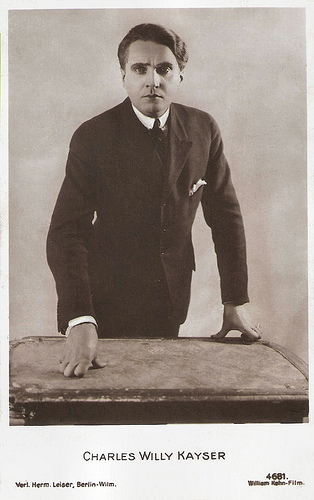
German postcard by Verlag Hermann Leiser, Berlin-Wilm., no. 4681. Photo: William Kahn-Film. Publicity still for Dämon der Welt. 1. Das Schicksal des Edgar Morton/Demon of the world, part 1: The fate of Edgar Morton (Rudolf Del Zopp, Siegfried Dessauer, 1919).
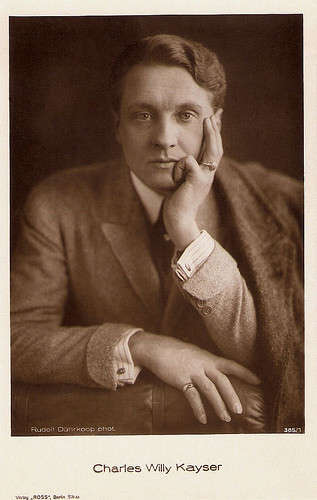
German postcard by Ross Verlag, Berlin, no.385/1, 1919-1924. Photo: Rudolph Dührkoop Phot.
Arrested for alleged espionage activities
Charles Wilhelm Kaiser was born in 1881, in Metz, part of the German Empire (now Moselle, France). He was the son of an officer, who served in the French army and grew up with her sister Martel. At the age of 17, he went to the Conservatory of the Musikverein (Society of Friends of the Music) in Vienna against the wishes of his parents. There he had a vocal training.
The 18-year-old had his stage debut in 1898 at the Hamburger Opera Ensemble as a lyric baritone in The Bivouac of Granada. In 1899 the jeune premier made his stage debut in Berlin. In Vienna, Kaiser was a guest actor at the opera house, and a company member of the Raimund Theater. He also performed in Karlsbad, Breslau, New York and Amsterdam. Between 1911 and 1914 Kayser worked at the renowned Burgtheater in Vienna.
In 1914, he moved to Riga, at the time part of the Russian Empire (now Latvia), where he became the head of the German Lustspielhaus. The outbreak of World War 1 at the end of July 1914 was a turning point in Kayser’s career. In August 1914 he was arrested by the Russian authorities for alleged espionage activities and together with his wife Betty abducted to Siberia in the Vyatka Governorate. Only after four years of suffering he managed to escape with help of the Swedish Red Cross.
Kaiser made his way back to Germany and arrived in Berlin completely without funds. There he received a commitment at the Lustspielhaus. About the same time the film career of the now over 35-year-old actor began. Among his first films were the silent dramas Sei getreu bis in den Tod/ Be true to death (Josef Stein, 1918) with Hanni Weisse , and Der siebente Kuß/The Seventh Kiss (Marie Luise Droop, 1918) with Hilde Woerner.
He also directed a few films, Die Autofahrt unter der Erde/The car ride under the ground (1920), Tschetschensen-Rache/Chechen Revenge (1920), Im Fasching der Sinne/In the carnival of the senses (1920) and Tanz der Leidenschaften/Dance of passions (1921).
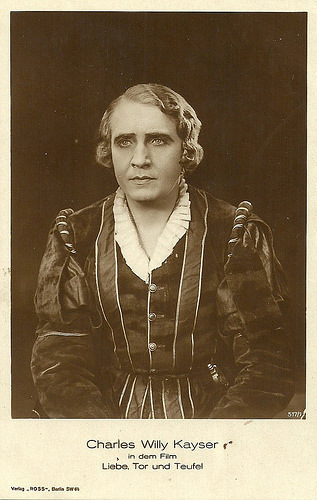
German postcard. Ross Verlag, no. 517/1, 1919-1924. Photo: publicity still for Liebe, Tor und Teufel/Love, Gate and Devil (Adolf Wenter, 1922).
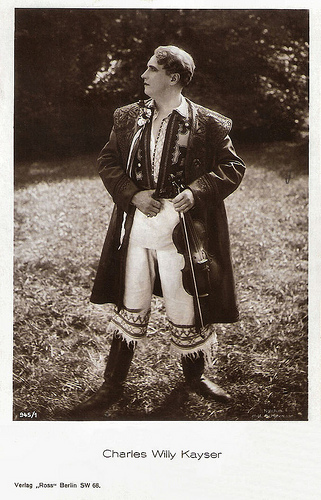
German postcard by Ross Verlag, no. 945/1. Photo: Schuhmann / Noto-Film. Publicity still for Die blonde Geisha/The blonde geisha ( Ludwig Czerny, 1923).
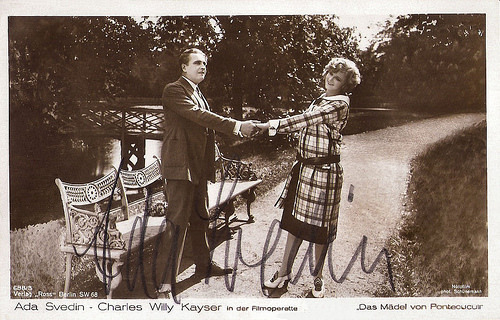
German postcard by Ross Verlag, no. 688/5, 1919-1924. Photo: Noto-Film / Schünemann. Publicity still for the silent operetta film Das Mädel von Pontecuculi/The Girl from Pontecuculi (Ludwig Czerny, 1924) with Ada Svedin .
A highly diverse, multi-faceted film actor
Charles Willy Kayser became a highly diverse, multi-faceted film actor. He appeared in such genres as the crime film and the melodrama which were very popular in these years. He often played people of rank, including officers, princes, or counts, but among his characters are also villagers and detectives.
His early films include the Mia May vehicle Fräulein Zahnarzt/Miss Dentist (Joe May, 1919), as the fiancé of the heroine. With Mia May he also appeared in the comedy Der Amönenhof/The Amönenhof (Uwe Jens Krafft, 1920) as Count Leo von Zimburg.
In the melodrama Va banque/The Winner (Léo Lasko, 1920) he played a gambler, and in the drama Der ewige Fluch/The eternal curse (Fritz Wendhausen, 1921) he was sailor Jan Graat. Especially in the years 1920-1924 Kayser appeared in countless silent films. He played officers in Die elf schillschen Offiziere/Eleven Who Were Loyal (Rudolf Meinert, 1926) and Unsere Emden/Our Emden (Louis Ralph, 1926).
He played at the side of Asta Nielsen in the drugs drama Laster der Menschheit/Vices of mankind (Rudolf Meinert 1927). He also appeared in Karl Grune's monumental historical film Waterloo (1927) as King Friedrich Wilhelm III opposite Charles Vanel as Napoleon.
One of his last silent films was the thriller Masken/Masks (Rudolf Meinert, 1929) from the Stuart Webbs crime film series. Alongside Karl Ludwig Diehl as Stuart Webbs, Kayser appeared as banker Clifford, who is involved in a mysterious attack.
After the arrival of sound film, Kayser played mainly small supporting roles. His last screen appearances were in the propaganda films Venus vor Gericht/Venus in court (Hans H. Zerlett, 1941) and Kameraden/Comrades (Hans Schweikart, 1941). Despite his poor health - he suffered from hypertension - he had been forced by the Nazis to continue to work as an actor. After an appearance in the Baltic Sea resort Ahlbeck he broke down, suffered a cerebral hemorrhage and died the following day in a hospital in Berlin.
Charles Willy Kayser was married to Betty Szalok, an opera singer from Hungary, with whom he had a daughter, Vera. Shortly after the death of Betty Szalok in 1938, Kayser gave the yes-word to 30-years-younger artist Ruth Sersen. Their daughter Gabriella, named Gaby, had already been born in Munich in 1929.
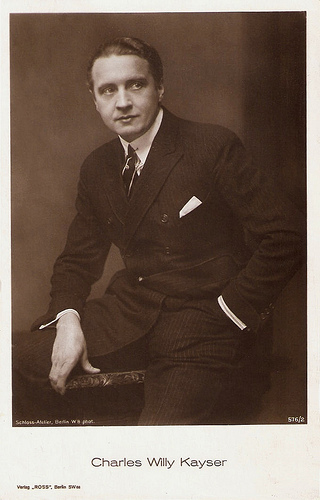
German postcard by Ross Verlag, Berlin, no. 576/2, 1919-1924. Photo: Schloss Atelier, Berlin.
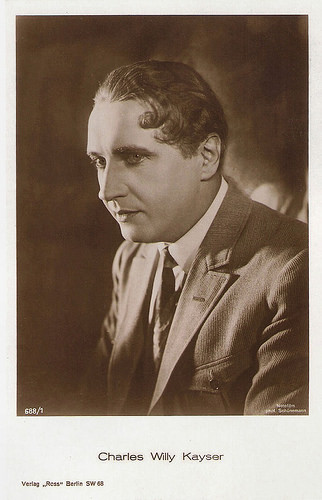
German postcard by Ross Verlag, Berlin, no. 688/1, 1919-1924. Photo: Notofilm / Schünemann.
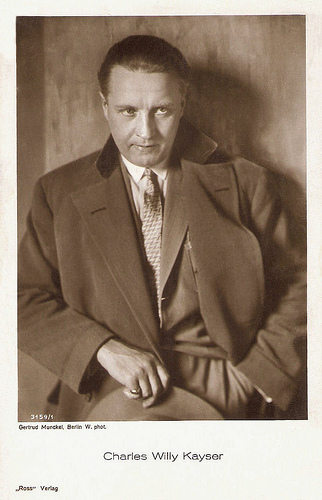
German postcard by Ross Verlag, Berlin, no. 3159/1, 1928-1929. Photo: Gertrud Munckel, Berlin.
Sources: Stephanie D’heil (Steffi-line - German), Thomas Staedeli (Cyranos - German), Wikipedia (German) and .

German postcard by Verlag Hermann Leiser, Berlin-Wilm., no. 4681. Photo: William Kahn-Film. Publicity still for Dämon der Welt. 1. Das Schicksal des Edgar Morton/Demon of the world, part 1: The fate of Edgar Morton (Rudolf Del Zopp, Siegfried Dessauer, 1919).

German postcard by Ross Verlag, Berlin, no.385/1, 1919-1924. Photo: Rudolph Dührkoop Phot.
Arrested for alleged espionage activities
Charles Wilhelm Kaiser was born in 1881, in Metz, part of the German Empire (now Moselle, France). He was the son of an officer, who served in the French army and grew up with her sister Martel. At the age of 17, he went to the Conservatory of the Musikverein (Society of Friends of the Music) in Vienna against the wishes of his parents. There he had a vocal training.
The 18-year-old had his stage debut in 1898 at the Hamburger Opera Ensemble as a lyric baritone in The Bivouac of Granada. In 1899 the jeune premier made his stage debut in Berlin. In Vienna, Kaiser was a guest actor at the opera house, and a company member of the Raimund Theater. He also performed in Karlsbad, Breslau, New York and Amsterdam. Between 1911 and 1914 Kayser worked at the renowned Burgtheater in Vienna.
In 1914, he moved to Riga, at the time part of the Russian Empire (now Latvia), where he became the head of the German Lustspielhaus. The outbreak of World War 1 at the end of July 1914 was a turning point in Kayser’s career. In August 1914 he was arrested by the Russian authorities for alleged espionage activities and together with his wife Betty abducted to Siberia in the Vyatka Governorate. Only after four years of suffering he managed to escape with help of the Swedish Red Cross.
Kaiser made his way back to Germany and arrived in Berlin completely without funds. There he received a commitment at the Lustspielhaus. About the same time the film career of the now over 35-year-old actor began. Among his first films were the silent dramas Sei getreu bis in den Tod/ Be true to death (Josef Stein, 1918) with Hanni Weisse , and Der siebente Kuß/The Seventh Kiss (Marie Luise Droop, 1918) with Hilde Woerner.
He also directed a few films, Die Autofahrt unter der Erde/The car ride under the ground (1920), Tschetschensen-Rache/Chechen Revenge (1920), Im Fasching der Sinne/In the carnival of the senses (1920) and Tanz der Leidenschaften/Dance of passions (1921).

German postcard. Ross Verlag, no. 517/1, 1919-1924. Photo: publicity still for Liebe, Tor und Teufel/Love, Gate and Devil (Adolf Wenter, 1922).

German postcard by Ross Verlag, no. 945/1. Photo: Schuhmann / Noto-Film. Publicity still for Die blonde Geisha/The blonde geisha ( Ludwig Czerny, 1923).

German postcard by Ross Verlag, no. 688/5, 1919-1924. Photo: Noto-Film / Schünemann. Publicity still for the silent operetta film Das Mädel von Pontecuculi/The Girl from Pontecuculi (Ludwig Czerny, 1924) with Ada Svedin .
A highly diverse, multi-faceted film actor
Charles Willy Kayser became a highly diverse, multi-faceted film actor. He appeared in such genres as the crime film and the melodrama which were very popular in these years. He often played people of rank, including officers, princes, or counts, but among his characters are also villagers and detectives.
His early films include the Mia May vehicle Fräulein Zahnarzt/Miss Dentist (Joe May, 1919), as the fiancé of the heroine. With Mia May he also appeared in the comedy Der Amönenhof/The Amönenhof (Uwe Jens Krafft, 1920) as Count Leo von Zimburg.
In the melodrama Va banque/The Winner (Léo Lasko, 1920) he played a gambler, and in the drama Der ewige Fluch/The eternal curse (Fritz Wendhausen, 1921) he was sailor Jan Graat. Especially in the years 1920-1924 Kayser appeared in countless silent films. He played officers in Die elf schillschen Offiziere/Eleven Who Were Loyal (Rudolf Meinert, 1926) and Unsere Emden/Our Emden (Louis Ralph, 1926).
He played at the side of Asta Nielsen in the drugs drama Laster der Menschheit/Vices of mankind (Rudolf Meinert 1927). He also appeared in Karl Grune's monumental historical film Waterloo (1927) as King Friedrich Wilhelm III opposite Charles Vanel as Napoleon.
One of his last silent films was the thriller Masken/Masks (Rudolf Meinert, 1929) from the Stuart Webbs crime film series. Alongside Karl Ludwig Diehl as Stuart Webbs, Kayser appeared as banker Clifford, who is involved in a mysterious attack.
After the arrival of sound film, Kayser played mainly small supporting roles. His last screen appearances were in the propaganda films Venus vor Gericht/Venus in court (Hans H. Zerlett, 1941) and Kameraden/Comrades (Hans Schweikart, 1941). Despite his poor health - he suffered from hypertension - he had been forced by the Nazis to continue to work as an actor. After an appearance in the Baltic Sea resort Ahlbeck he broke down, suffered a cerebral hemorrhage and died the following day in a hospital in Berlin.
Charles Willy Kayser was married to Betty Szalok, an opera singer from Hungary, with whom he had a daughter, Vera. Shortly after the death of Betty Szalok in 1938, Kayser gave the yes-word to 30-years-younger artist Ruth Sersen. Their daughter Gabriella, named Gaby, had already been born in Munich in 1929.

German postcard by Ross Verlag, Berlin, no. 576/2, 1919-1924. Photo: Schloss Atelier, Berlin.

German postcard by Ross Verlag, Berlin, no. 688/1, 1919-1924. Photo: Notofilm / Schünemann.

German postcard by Ross Verlag, Berlin, no. 3159/1, 1928-1929. Photo: Gertrud Munckel, Berlin.
Sources: Stephanie D’heil (Steffi-line - German), Thomas Staedeli (Cyranos - German), Wikipedia (German) and .
Published on February 02, 2017 22:00
February 1, 2017
De Vlaschaard (1943)
The Belgian-German production De Vlaschaard (Boleslaw Barlog, 1943) was an adaptation of the Flemish 1907 novel of the same name by Stijn Streuvels. The film's premiere was at the Ghent cinema Capitool on 28 August 1943.
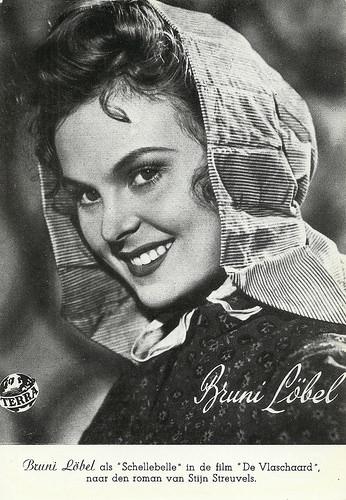
Belgian postcard. Photo: Terra Film. Bruni Löbel plays Schellebelle in De Vlaschaard (Boleslaw Barlog, 1943).
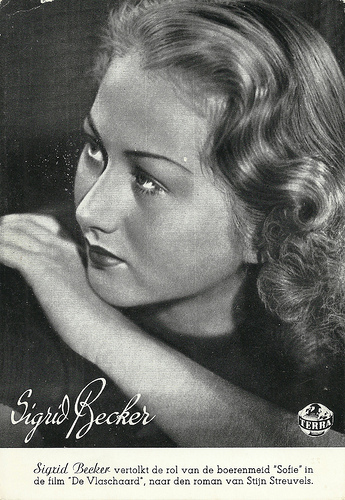
Belgian postcard. Photo: Terra Film. Sigrid Becker plays the maid Sofie in De Vlaschaard (Boleslaw Barlog, 1943).
A farmers' film of high quality
During the Second World War, in occupied Belgium the German Terra Film company shot a rural drama based on the novel De Vlaschaard by Flemish author Stijn Streuvels about the generational conflict between a farmer and his son.
In 1942 Terra started with the shooting of the film, which finally would be released in Germany as Wenn die Sonne wieder scheint/When the Sun Shines Again in 1943. The film was partly shot in and around the city of Kortrijk/Courtrai.
Streuvels himself and dozens of people from the region acted as extras in the film, while the leads were for Paul Wegener , famous from the German Expressionist films like Der Golem, and Paul Klinger , who just before had acted in Veit Harlan 's Die goldene Stadt, starring Kristina Söderbaum .
German propaganda minister Joseph Goebbels personally viewed the film and noted in his diary that 'Flachsacker' as it was initially called, was a farmers' film of high quality. According to him this was the first film that showed the farmer's world on an artistically high level.
Hardliners in the Flemish SS though the dubbing too Dutch, and the adaptation as well too little Flemish. The producer also altered scenes to make it more attractive for a big audience, so the love interest became bigger, more humour was added, and the ending was less tragic.
The film fared rather well in Belgian and Dutch cinemas at the time. Many Flemish people went to see it.
Being a doomed film for decades for its Nazi background, in 2007 an initiative rose to restore the film and Cinematek Brussels restored both its German spoken and its Dutch dubbed version. The results were a DVD, a stage play and a book, curated by Roel Vande Winkel and Ine Van Lindhout. Just like in 1943, the Flemish press was divided whether this was a good film or not.
The novel De Vlaschaard would be adapted for film again in 1983 by Jan Gruyaert. Vic Moeremans, who played farmer Vermeulen in the new version, won a Golden Calf for his part at the Dutch Film Festival that year.
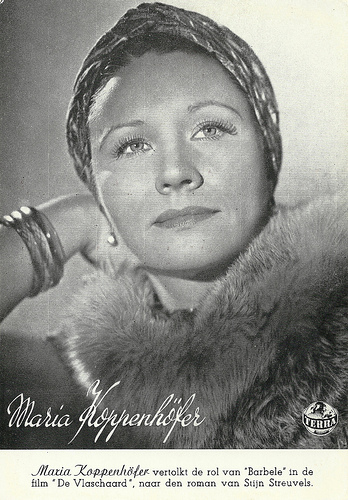
Belgian postcard. Photo: Terra Film. Maria Koppenhöfer plays Barbele in De Vlaschaard (Boleslaw Barlog, 1943).
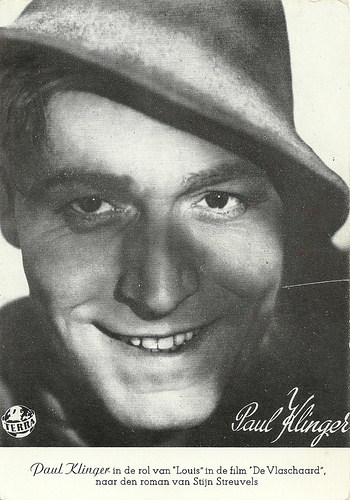
Belgian postcard. Photo: Terra. Paul Klinger as Louis in De Vlaschaard (Boleslaw Barlog, 1943).
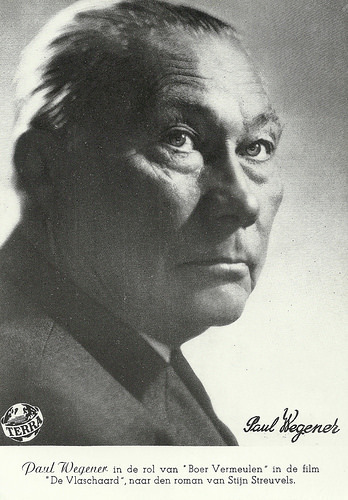
Belgian postcard. Photo: Terra. Paul Wegener as Boer (Farmer) Vermeulen in De Vlaschaard (Boleslaw Barlog, 1943).
Sources: Wikipedia (Dutch) and IMDb.

Belgian postcard. Photo: Terra Film. Bruni Löbel plays Schellebelle in De Vlaschaard (Boleslaw Barlog, 1943).

Belgian postcard. Photo: Terra Film. Sigrid Becker plays the maid Sofie in De Vlaschaard (Boleslaw Barlog, 1943).
A farmers' film of high quality
During the Second World War, in occupied Belgium the German Terra Film company shot a rural drama based on the novel De Vlaschaard by Flemish author Stijn Streuvels about the generational conflict between a farmer and his son.
In 1942 Terra started with the shooting of the film, which finally would be released in Germany as Wenn die Sonne wieder scheint/When the Sun Shines Again in 1943. The film was partly shot in and around the city of Kortrijk/Courtrai.
Streuvels himself and dozens of people from the region acted as extras in the film, while the leads were for Paul Wegener , famous from the German Expressionist films like Der Golem, and Paul Klinger , who just before had acted in Veit Harlan 's Die goldene Stadt, starring Kristina Söderbaum .
German propaganda minister Joseph Goebbels personally viewed the film and noted in his diary that 'Flachsacker' as it was initially called, was a farmers' film of high quality. According to him this was the first film that showed the farmer's world on an artistically high level.
Hardliners in the Flemish SS though the dubbing too Dutch, and the adaptation as well too little Flemish. The producer also altered scenes to make it more attractive for a big audience, so the love interest became bigger, more humour was added, and the ending was less tragic.
The film fared rather well in Belgian and Dutch cinemas at the time. Many Flemish people went to see it.
Being a doomed film for decades for its Nazi background, in 2007 an initiative rose to restore the film and Cinematek Brussels restored both its German spoken and its Dutch dubbed version. The results were a DVD, a stage play and a book, curated by Roel Vande Winkel and Ine Van Lindhout. Just like in 1943, the Flemish press was divided whether this was a good film or not.
The novel De Vlaschaard would be adapted for film again in 1983 by Jan Gruyaert. Vic Moeremans, who played farmer Vermeulen in the new version, won a Golden Calf for his part at the Dutch Film Festival that year.

Belgian postcard. Photo: Terra Film. Maria Koppenhöfer plays Barbele in De Vlaschaard (Boleslaw Barlog, 1943).

Belgian postcard. Photo: Terra. Paul Klinger as Louis in De Vlaschaard (Boleslaw Barlog, 1943).

Belgian postcard. Photo: Terra. Paul Wegener as Boer (Farmer) Vermeulen in De Vlaschaard (Boleslaw Barlog, 1943).
Sources: Wikipedia (Dutch) and IMDb.
Published on February 01, 2017 22:00
January 31, 2017
David Anderson's 12 Favourite European Films
One of the finest online places to read original and always well-written reviews of old and new films is Bunched Undies. We invited the film connaisseur behind this blog, David Anderson, for a guest post. For EFSP, he selected twelve of his favourite European films. Click on the film titles for David's reviews at Bunched Undies. And we added to each film a vintage postcard.
The Cigarette Girl of Mosselprom (1924)
David Anderson: "The Cigarette Girl of Mosselprom is about a group of men who are passionately, and somewhat perplexingly, attracted to the same woman. Whether it’s her beguiling personality, her trim figure or her budding mustache, cigarette vendor Zina (Yuliya Solntseva) finds herself hip deep in would-be suitors."
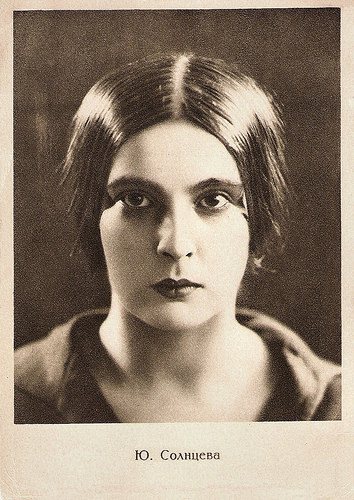
Yuliya Solntseva. Russian postcard.
Metropolis (1927)
"The film is a triumph of art direction and set design. The various technical marvels of this futuristic society are rendered in a geometric Art Deco style that is as beautiful today as it was 90 years ago. It is no stretch to say that this film has, at one time or another, been ripped off by every director and set designer in the profession."
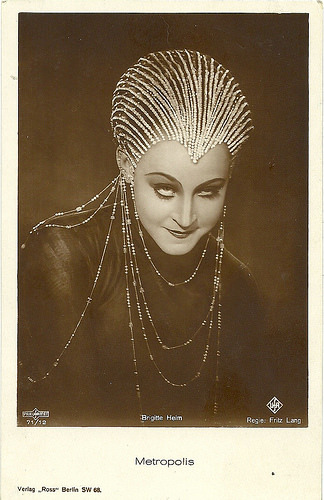
Brigitte Helm . German postcard by Ross Verlag, Berlin, no. 71/12. Photo: Ufa / Parufamet. Publicity still for Metropolis (Fritz Lang, 1927). Collection: Didier Hanson.
People on Sunday (1930)
"Produced during a rare period of calm in Germany’s early 20th Century history, People on Sunday was created by a dream team of gifted young filmmakers – Curt and Robert Siodmak (directors), Edgar Ulmer (producer), Billy Wilder (screenplay), Eugene Shufftan (DP) and Fred Zinnemann (Assistant Director) – all of whom would eventually immigrate to America and find varying degrees of success in Hollywood."
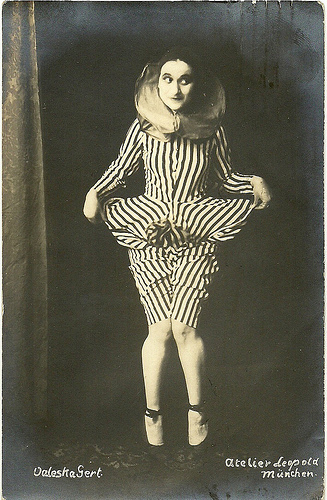
Valeska Gert (who appears as herself in Menschen am Sonntag/People on Sunday). German card. Photo: Atelier Leopold, München (Munich). Collection: Didier Hanson.
The Four Feathers (1939)
"John Clements, often derided as a wooden performer, is convincing here as a sensitive man struggling in a privileged world devoid of nuance, while Ralph Richardson is excellent as the jilted lover who cunningly decides to wait it out."
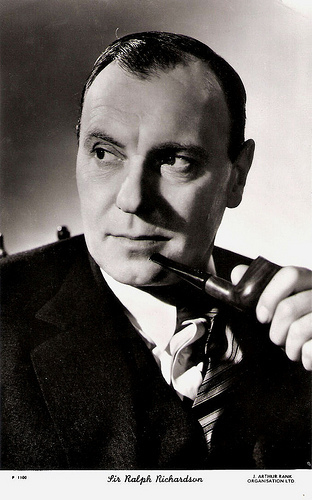
Ralph Richardson . British postcard by Show Parade Picture Service in The People series, no. P. 1100. Photo: J. Arthur Rank Organisation Ltd.
Beauty and the Beast (1946)
"Jean Cocteau’s retelling of the classic, familiar fable Beauty and the Beast is a perfect match of material and réalisateur. The Beast’s complex make-up, by Hagop Arakelian, is the film’s star special effect, and it compares favorably to today’s state of the art prosthetics. The Beast, played by Cocteau’s muse, protégé and long time lover Jean Marais, is still allowed a reasonable range of expressions despite Arakelian’s thick appliances."
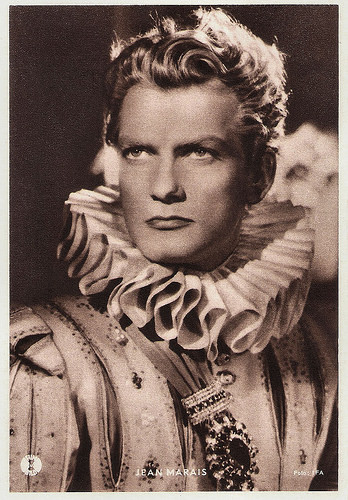
Jean Marais . German postcard by Filmbild. Photo: IFA. Publicity still for La belle et la bête/Beauty and the Beast (Jean Cocteau, 1946).
The Cranes are Flying (1951)
"A passionate love affair is torn apart by Hitler’s invasion of Russia in this Palme d’Or winner from director Mikhail Kalatozov. Veronica (Tatyana Samojlova) and Boris (Alesky Batalov) are young Muscovites fully enthralled with each other, and in the opening scenes we see them happily skip and frolic along the Volga and through a surreally deserted Red Square."
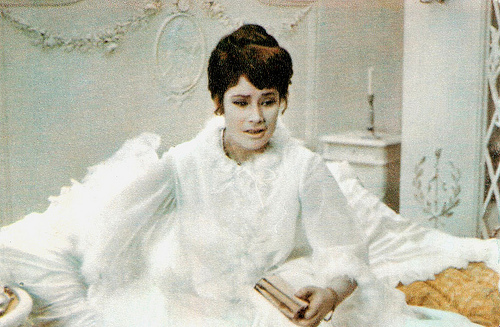
Tatyana Samojlova . Russian postcard by Izdanije Byuro Propogandy Sovietskogo Kinoiskusstva, no. A 08345, 1969. This postcard was printed in an edition of 500,000 cards. Retail price was 6 kop. Photo: publicity still for Anna Karenina (Aleksandr Zarkhi, 1967).
The Wages of Fear (1953)
"The Wages of Fear starts as a flabby, dawdling tale of class struggle in a squalid South American village, then morphs into a primeval drama of survival; as lean and mean as Yves Montand's sweaty undershirt."
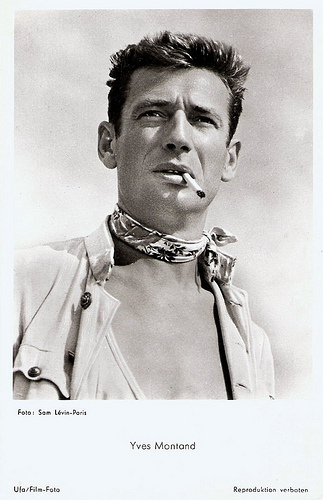
Yves Montand . German postcard by Ufa (Universum-Film Aktiengesellschaft), Berlin-Tempelhof, no. FK 658. Retail price: 25 Pfg. Photo: Sam Lévin, Paris. Publicity still for Le salaire de la peur/The Wages of Fear (Henri-Georges Clouzot, 1953).
French Cancan (1954)
"In 1954, director Jean Renoir crafted French Cancan, a loving Technicolor tribute to a notorious nightclub. In this fictionalized account, we follow the twisting path of a down-on-his-luck impresario named Danglard (Jean Gabin) and his dream of creating a truly democratic dancehall; a place where rich and poor, banker and baker, could mingle and enjoy a night of bawdy entertainment."
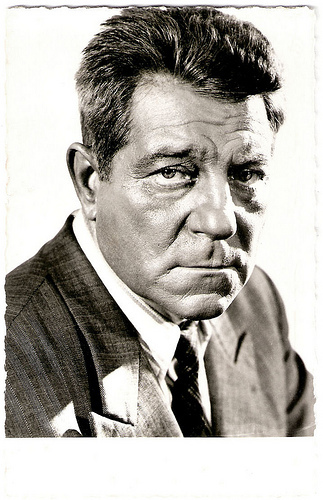
Jean Gabin . French postcard by Editions P.I., Paris, no. 1094. Offered by Les Carbones Korès 'Carboplane'. Photo: Marcel Bougureau.
La Strada (1954)
"Giulietta Masina is often described as Fellini’s muse, yet somehow the term doesn’t seem sufficient. Under Fellini’s direction, Masina’s pixie-ish characters remained cheery and upbeat, drawing on deep wells of strength despite their dreadful circumstances. La Strada is a film open to several roads of interpretation, including a thinly disguised retelling of Italy’s rise and fall from fascism."
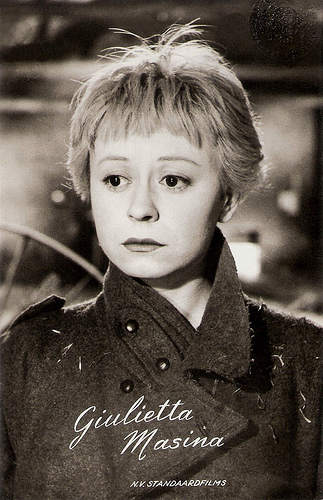
Giulietta Masina . Dutch postcard by Uitg. Takken, Utrecht, no. 3381. Photo: N.V. Standaardfilms. Publicity still for La strada (1954).
Wild Strawberries (1957)
"Wild Strawberries’ intoxicating blend of the gleefully pastoral with the grimly Kafkaesque continues to confound, compel and enthrall. It is a journey that melds fantasy and reality, past and present with handcrafted directness. As Dr. Borg (Victor Sjöström) confronts his deepest flaws and innermost demons amid the glorious natural bounty of summer, viewers are treated to supernatural insights and spectral visions on the mysteries of existence."
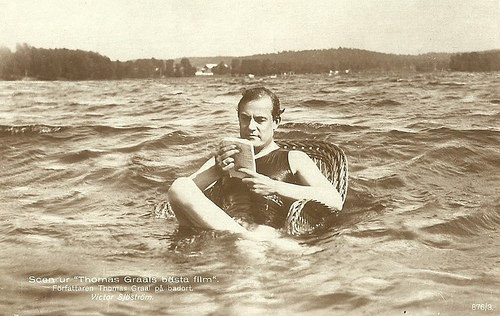
The young Victor Sjöström . Swedish postcard by Ed. Nordisk Konst, Stockholm, no. 876/3. Postcard for the Swedish silent film comedy Thomas Graals bästa film/Thomas Graal's Best Film (Mauritz Stiller, 1917).
Zazie dans le metro (1960)
"12 year old Zazie (Catherine Demongeot) has come to Paris for the weekend with her free spirited, widowed mother (Odette Piquet). She is dropped off with her uncle Gabriel (Philippe Noiret) for safekeeping, while Mom visits with the most recent of her string of ne’er-do-well boyfriends. Young Zazie is a child prodigy in at least two skill sets: seeing through adult deceptions and the blatant use of foul language, and she plies both of these talents with the effortless flair of a true master."

Catherine Demongeot. French card. Photo: René Mansat. Publicity still for Zazie dans le métro/Zazie in the Metro (Louis Malle, 1960).
Breathless (1960)
"Weened on the imagery of American gangster movies, Michel (Jean-Paul Belmondo) spends his aimless days pursuing the twin pleasures of petty theft and venery; a fat Gauloise perpetually dangling from his lips. Michel seems unable to think more than two hours ahead - the typical length of a movie in other words - but one day his short sighted hedonism results in more than existential ennui."
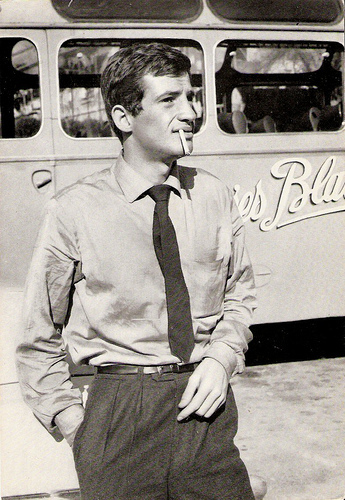
Jean-Paul Belmondo. German postcard by WS-Druck, Wanne-Eickel, no. 559.
Thanks, David! Two more classics on my still-must-see list.
The Cigarette Girl of Mosselprom (1924)
David Anderson: "The Cigarette Girl of Mosselprom is about a group of men who are passionately, and somewhat perplexingly, attracted to the same woman. Whether it’s her beguiling personality, her trim figure or her budding mustache, cigarette vendor Zina (Yuliya Solntseva) finds herself hip deep in would-be suitors."

Yuliya Solntseva. Russian postcard.
Metropolis (1927)
"The film is a triumph of art direction and set design. The various technical marvels of this futuristic society are rendered in a geometric Art Deco style that is as beautiful today as it was 90 years ago. It is no stretch to say that this film has, at one time or another, been ripped off by every director and set designer in the profession."

Brigitte Helm . German postcard by Ross Verlag, Berlin, no. 71/12. Photo: Ufa / Parufamet. Publicity still for Metropolis (Fritz Lang, 1927). Collection: Didier Hanson.
People on Sunday (1930)
"Produced during a rare period of calm in Germany’s early 20th Century history, People on Sunday was created by a dream team of gifted young filmmakers – Curt and Robert Siodmak (directors), Edgar Ulmer (producer), Billy Wilder (screenplay), Eugene Shufftan (DP) and Fred Zinnemann (Assistant Director) – all of whom would eventually immigrate to America and find varying degrees of success in Hollywood."

Valeska Gert (who appears as herself in Menschen am Sonntag/People on Sunday). German card. Photo: Atelier Leopold, München (Munich). Collection: Didier Hanson.
The Four Feathers (1939)
"John Clements, often derided as a wooden performer, is convincing here as a sensitive man struggling in a privileged world devoid of nuance, while Ralph Richardson is excellent as the jilted lover who cunningly decides to wait it out."

Ralph Richardson . British postcard by Show Parade Picture Service in The People series, no. P. 1100. Photo: J. Arthur Rank Organisation Ltd.
Beauty and the Beast (1946)
"Jean Cocteau’s retelling of the classic, familiar fable Beauty and the Beast is a perfect match of material and réalisateur. The Beast’s complex make-up, by Hagop Arakelian, is the film’s star special effect, and it compares favorably to today’s state of the art prosthetics. The Beast, played by Cocteau’s muse, protégé and long time lover Jean Marais, is still allowed a reasonable range of expressions despite Arakelian’s thick appliances."

Jean Marais . German postcard by Filmbild. Photo: IFA. Publicity still for La belle et la bête/Beauty and the Beast (Jean Cocteau, 1946).
The Cranes are Flying (1951)
"A passionate love affair is torn apart by Hitler’s invasion of Russia in this Palme d’Or winner from director Mikhail Kalatozov. Veronica (Tatyana Samojlova) and Boris (Alesky Batalov) are young Muscovites fully enthralled with each other, and in the opening scenes we see them happily skip and frolic along the Volga and through a surreally deserted Red Square."

Tatyana Samojlova . Russian postcard by Izdanije Byuro Propogandy Sovietskogo Kinoiskusstva, no. A 08345, 1969. This postcard was printed in an edition of 500,000 cards. Retail price was 6 kop. Photo: publicity still for Anna Karenina (Aleksandr Zarkhi, 1967).
The Wages of Fear (1953)
"The Wages of Fear starts as a flabby, dawdling tale of class struggle in a squalid South American village, then morphs into a primeval drama of survival; as lean and mean as Yves Montand's sweaty undershirt."

Yves Montand . German postcard by Ufa (Universum-Film Aktiengesellschaft), Berlin-Tempelhof, no. FK 658. Retail price: 25 Pfg. Photo: Sam Lévin, Paris. Publicity still for Le salaire de la peur/The Wages of Fear (Henri-Georges Clouzot, 1953).
French Cancan (1954)
"In 1954, director Jean Renoir crafted French Cancan, a loving Technicolor tribute to a notorious nightclub. In this fictionalized account, we follow the twisting path of a down-on-his-luck impresario named Danglard (Jean Gabin) and his dream of creating a truly democratic dancehall; a place where rich and poor, banker and baker, could mingle and enjoy a night of bawdy entertainment."

Jean Gabin . French postcard by Editions P.I., Paris, no. 1094. Offered by Les Carbones Korès 'Carboplane'. Photo: Marcel Bougureau.
La Strada (1954)
"Giulietta Masina is often described as Fellini’s muse, yet somehow the term doesn’t seem sufficient. Under Fellini’s direction, Masina’s pixie-ish characters remained cheery and upbeat, drawing on deep wells of strength despite their dreadful circumstances. La Strada is a film open to several roads of interpretation, including a thinly disguised retelling of Italy’s rise and fall from fascism."

Giulietta Masina . Dutch postcard by Uitg. Takken, Utrecht, no. 3381. Photo: N.V. Standaardfilms. Publicity still for La strada (1954).
Wild Strawberries (1957)
"Wild Strawberries’ intoxicating blend of the gleefully pastoral with the grimly Kafkaesque continues to confound, compel and enthrall. It is a journey that melds fantasy and reality, past and present with handcrafted directness. As Dr. Borg (Victor Sjöström) confronts his deepest flaws and innermost demons amid the glorious natural bounty of summer, viewers are treated to supernatural insights and spectral visions on the mysteries of existence."

The young Victor Sjöström . Swedish postcard by Ed. Nordisk Konst, Stockholm, no. 876/3. Postcard for the Swedish silent film comedy Thomas Graals bästa film/Thomas Graal's Best Film (Mauritz Stiller, 1917).
Zazie dans le metro (1960)
"12 year old Zazie (Catherine Demongeot) has come to Paris for the weekend with her free spirited, widowed mother (Odette Piquet). She is dropped off with her uncle Gabriel (Philippe Noiret) for safekeeping, while Mom visits with the most recent of her string of ne’er-do-well boyfriends. Young Zazie is a child prodigy in at least two skill sets: seeing through adult deceptions and the blatant use of foul language, and she plies both of these talents with the effortless flair of a true master."

Catherine Demongeot. French card. Photo: René Mansat. Publicity still for Zazie dans le métro/Zazie in the Metro (Louis Malle, 1960).
Breathless (1960)
"Weened on the imagery of American gangster movies, Michel (Jean-Paul Belmondo) spends his aimless days pursuing the twin pleasures of petty theft and venery; a fat Gauloise perpetually dangling from his lips. Michel seems unable to think more than two hours ahead - the typical length of a movie in other words - but one day his short sighted hedonism results in more than existential ennui."

Jean-Paul Belmondo. German postcard by WS-Druck, Wanne-Eickel, no. 559.
Thanks, David! Two more classics on my still-must-see list.
Published on January 31, 2017 22:00
January 30, 2017
EFSP starts 2017 with a new pageview record
2016 was an excellent year for EFSP. For the first time since May 2010, when we started counting, there were more than 90,000 pageviews in one month in July 2016. December 2016 was even better when we passed the magical number of 100,000. This month, January 2017, the party got even busier and Blogger counted more than 120,000 pageviews for EFSP this year already. So thank you, for visiting EFSP! My special thanks go to Ivo, Egbert, Didier, Marlene (check out her latest post about female stars who passed away in 2016 at La Collectionneuse) and the other friends who help and advise. Tomorrow you'll find here a guest post of one of these friends, David Anderson of the blog Bunched Undies and a week later a new guest post by Didier Hanson. Today we remember a wonderful gift of three years ago. When we returned from our holidays in Italy in 2014, there was this little parcel from East-Hartford, USA, waiting for us at our neighbour's house. It contained rare postcards, photos and a clipping on the Ukrainian-born silent film star Xenia Desni and her daughter Tamara Desni, who had an impressive film and stage career herself in Great Britain. The postcards were sent to us by a relative of the Desni's, their niece Tatiana. In the past, Tatiana had already sent us some scans of the postcards of Tamara Desni and now she gave us the 39 Ross Verlag postcards, which she had collected as a little girl. Again, thanks Tatiana!

Austrian photo by Willinger, Wien. From Tatiana. Xenia Desni and Livio Pavanelli in the German silent film Die letzte Einquartierung aka Küssen ist keine Sünd'/Kissing is no sin (Rudolf Walther-Fein, Rudolf Dworsky, 1926).
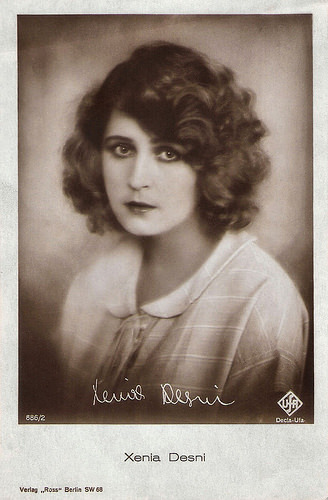
German postcard by Ross Verlag, no. 886/2, 1925-1926. Photo: Decla / Ufa. From Tatiana.
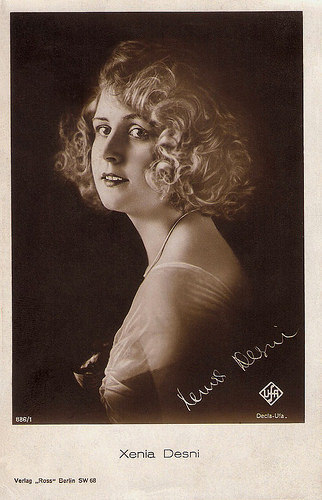
German postcard by Ross Verlag, no. 886/1, 1925-1926. Photo: Decla / Ufa. From Tatiana.
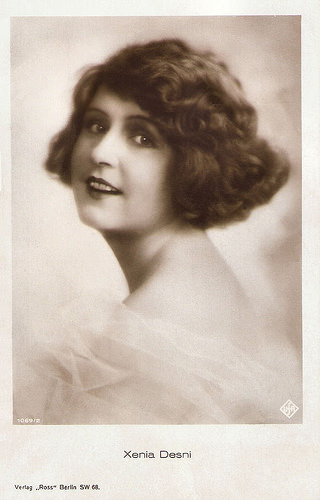
German postcard by Ross Verlag, no. 1069/2, 1927-1928. Photo: Ufa. From Tatiana.
Xenia Desni
Ukrainian-born actress Xenia Desni (1894-1954) was a star of the German silent cinema. Xenia - also known as Dada - was born in Kiev, but travelled at the beginning of the 1920s to Berlin.
She made her film debut with Sappho (Dimitri Buchowetzki, 1921). She often worked with director Johannes Guter such as for her breakthrough film Die Prinzessin Suwarin/The Princess Suwarin (1923) starring Lil Dagover .
In the next years followed other successful productions such as Die Andere/The Other (Gerhard Lamprecht, 1924). An international hit became the silent operetta Ein Walzertraum/A Waltz Dream (Ludwig Berger, 1925) with Willy Fritsch .
This was followed by Familie Schimeck/The Schimeck Family (Alfred Halm, Rudolf Dworsky, 1926), Madame wagt einen Seitensprung/Madam dares an Escapade (Hans Otto, 1927), and Erzherzog Johann/Archduke John (Max Neufeld, 1929).
After the coming of sound film, her career soon ended. But Xenia helped to shape the film and stage career of her beautiful daughter.
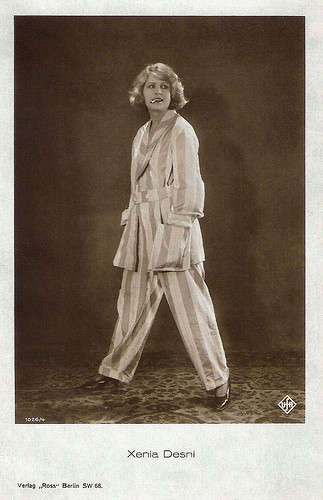
German postcard by Ross Verlag, no. 1026/4, 1927-1928. Photo: Ufa. From Tatiana.
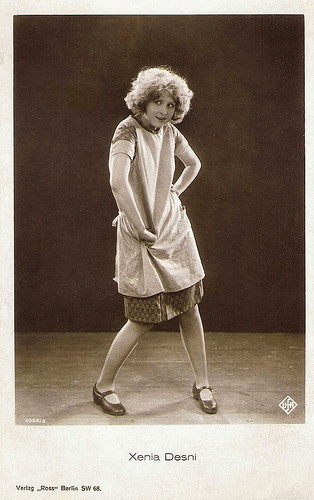
German postcard by Ross Verlag, no. 1028/2, 1927-1928. Photo: Ufa. From Tatiana.
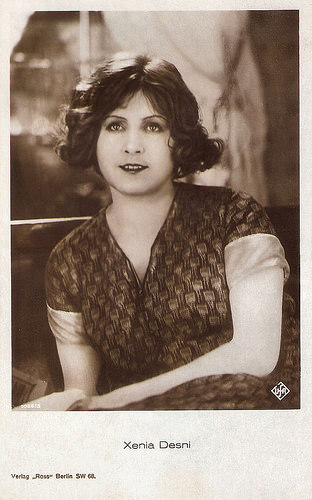
German postcard by Ross Verlag, no. 1026/3, 1927-1928. Photo: Ufa. From Tatiana.
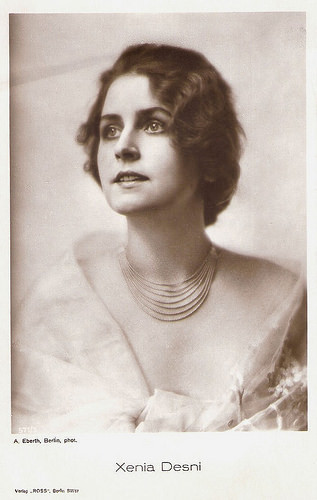
German postcard by Ross Verlag, no. 571/3, 1919-1924. Photo: A. Eberth, Berlin. From Tatiana.
Tamara Desni
Tamara Desni (1910–2008) started her stage and film career as a child in Berlin. Tamara acted in three German sound films before leaving with her mother to Great Britain.
In 1931, she made her triumphant London stage debut in the operetta White Horse Inn. For this spectacular production, the entire Coliseum theatre was transformed into the Tyrol. The production was based on the German operetta Im weissen Roessl. White Horse Inn was a smash hit and ran for 500 performances at the Coliseum. The production is even credited with saving the theatre, which was faltering as a music hall.
Tamara followed this up with another leading role in a German import at the Coliseum, the musical Casanova, featuring music by Johann Strauss, Jr.
Desni's British film career took off with the comedy Falling for You (Robert Stevenson, Jack Hulbert, 1933), supporting the popular musical comedy team of Jack Hulbert and Cicely Courtneidge .
Later films included the thriller Forbidden Territory (Phil Rosen, 1934), another Jack Hulbert comedy Jack Ahoy (Walter Forde, 1935) and the historical drama Fire Over England (William K. Howard, 1937), with Laurence Olivier and Vivien Leigh .
Tamara Desni’s film career continued through 1950. After that she moved to the South of France, where her bar and restaurant L'Auberge Chez Tamara, became a popular attraction around Grasse in the Alpes Maritimes.
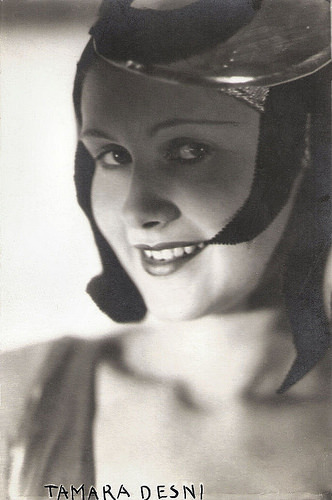
German postcard for Otto Kurt Vogelsang Lichtbildner, Berlin. From Tatiana.
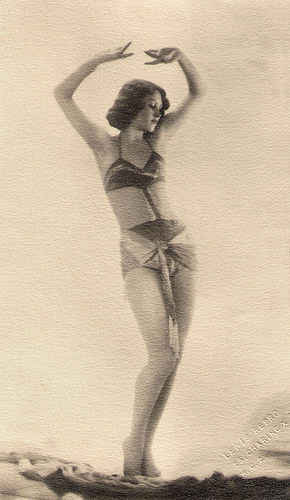
British postcard. From Tatiana.
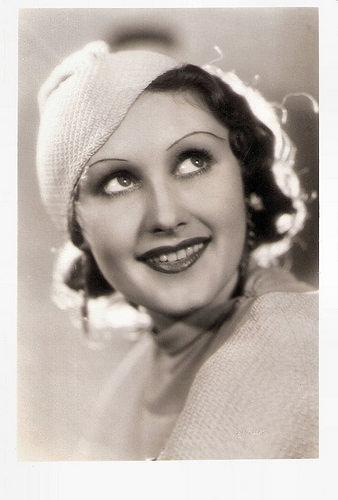
British postcard. From Tatiana.
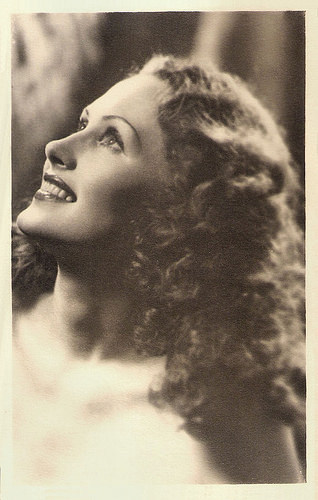
British photo by Vivienne 20th Century Studios Ltd, London. From Tatiana.

Austrian photo by Willinger, Wien. From Tatiana. Xenia Desni and Livio Pavanelli in the German silent film Die letzte Einquartierung aka Küssen ist keine Sünd'/Kissing is no sin (Rudolf Walther-Fein, Rudolf Dworsky, 1926).

German postcard by Ross Verlag, no. 886/2, 1925-1926. Photo: Decla / Ufa. From Tatiana.

German postcard by Ross Verlag, no. 886/1, 1925-1926. Photo: Decla / Ufa. From Tatiana.

German postcard by Ross Verlag, no. 1069/2, 1927-1928. Photo: Ufa. From Tatiana.
Xenia Desni
Ukrainian-born actress Xenia Desni (1894-1954) was a star of the German silent cinema. Xenia - also known as Dada - was born in Kiev, but travelled at the beginning of the 1920s to Berlin.
She made her film debut with Sappho (Dimitri Buchowetzki, 1921). She often worked with director Johannes Guter such as for her breakthrough film Die Prinzessin Suwarin/The Princess Suwarin (1923) starring Lil Dagover .
In the next years followed other successful productions such as Die Andere/The Other (Gerhard Lamprecht, 1924). An international hit became the silent operetta Ein Walzertraum/A Waltz Dream (Ludwig Berger, 1925) with Willy Fritsch .
This was followed by Familie Schimeck/The Schimeck Family (Alfred Halm, Rudolf Dworsky, 1926), Madame wagt einen Seitensprung/Madam dares an Escapade (Hans Otto, 1927), and Erzherzog Johann/Archduke John (Max Neufeld, 1929).
After the coming of sound film, her career soon ended. But Xenia helped to shape the film and stage career of her beautiful daughter.

German postcard by Ross Verlag, no. 1026/4, 1927-1928. Photo: Ufa. From Tatiana.

German postcard by Ross Verlag, no. 1028/2, 1927-1928. Photo: Ufa. From Tatiana.

German postcard by Ross Verlag, no. 1026/3, 1927-1928. Photo: Ufa. From Tatiana.

German postcard by Ross Verlag, no. 571/3, 1919-1924. Photo: A. Eberth, Berlin. From Tatiana.
Tamara Desni
Tamara Desni (1910–2008) started her stage and film career as a child in Berlin. Tamara acted in three German sound films before leaving with her mother to Great Britain.
In 1931, she made her triumphant London stage debut in the operetta White Horse Inn. For this spectacular production, the entire Coliseum theatre was transformed into the Tyrol. The production was based on the German operetta Im weissen Roessl. White Horse Inn was a smash hit and ran for 500 performances at the Coliseum. The production is even credited with saving the theatre, which was faltering as a music hall.
Tamara followed this up with another leading role in a German import at the Coliseum, the musical Casanova, featuring music by Johann Strauss, Jr.
Desni's British film career took off with the comedy Falling for You (Robert Stevenson, Jack Hulbert, 1933), supporting the popular musical comedy team of Jack Hulbert and Cicely Courtneidge .
Later films included the thriller Forbidden Territory (Phil Rosen, 1934), another Jack Hulbert comedy Jack Ahoy (Walter Forde, 1935) and the historical drama Fire Over England (William K. Howard, 1937), with Laurence Olivier and Vivien Leigh .
Tamara Desni’s film career continued through 1950. After that she moved to the South of France, where her bar and restaurant L'Auberge Chez Tamara, became a popular attraction around Grasse in the Alpes Maritimes.

German postcard for Otto Kurt Vogelsang Lichtbildner, Berlin. From Tatiana.

British postcard. From Tatiana.

British postcard. From Tatiana.

British photo by Vivienne 20th Century Studios Ltd, London. From Tatiana.
Published on January 30, 2017 22:00
January 29, 2017
Glynis Johns
Husky voiced Glynis Johns (1923) is a retired Welsh stage and film actress, dancer, pianist and singer. She is best known for her film roles as a mermaid in the British comedy Miranda (1948) and as suffragette mother Winifred Banks in Walt Disney's Mary Poppins (1964). On Broadway, she created the role of Desiree Armfeldt in A Little Night Music, for which she won a Tony Award.
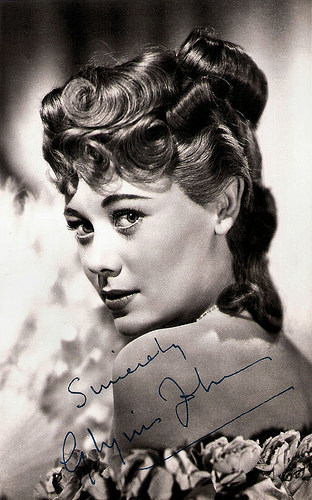
British autograph card. Publicity still for An Ideal Husband (Alexander Korda, 1947).
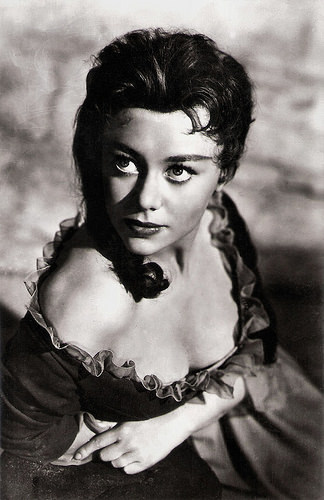
Vintage card. Photo: publicity still for Rob Roy, The Highland Rogue (Harold French, 1953).
A playful mermaid
Glynis Margaret P. Johns was born in 1923 in Pretoria, South Africa. She was the daughter of pianist Alys Maude (née Steele-Payne), and the British stage and film actor Mervyn Johns. Her parents were performing on tour in Pretoria when Glynis was born.
Glynis attended Clifton High School in Bristol for a short time. In 1935, she made her first stage appearance in Buckie's Bears as a child ballerina.
She made her film debut in the Alexander Korda production South Riding (Victor Saville, 1938) with Edna Best. She had a supporting part in the British war drama 49th Parallel/The Invaders (1941), the third film made by the writer-director team of Michael Powell and Emeric Pressburger.
In 1944, she appeared with her father in the drama Halfway House (Basil Dearden, 1944) about ten people who are drawn to stay in an old hotel in a remote Welsh village. In 1948 she starred as a beautiful and playful mermaid in the comedy Miranda (Ken Annakin, 1948) and later reprised the role in the sequel, Mad About Men (Ralph Thomas, 1954).
In the aviation drama No Highway in the Sky/No Highway (Henry Koster, 1951) she co-starred with James Stewart and
Johns then made a successful transition to Hollywood, appearing in Personal Affair (Anthony Pelissier, 1953), starring Gene Tierney, and in The Court Jester (Melvin Frank, Norman Panama, 1956) as Danny Kaye's love interest. The following year, she starred in the Christmas film All Mine to Give (Allen Reisner, 1957). Johns received an Academy Award nomination for Best Supporting Actress for The Sundowners (Fred Zinnemann, 1960), starring Deborah Kerr and Robert Mitchum.
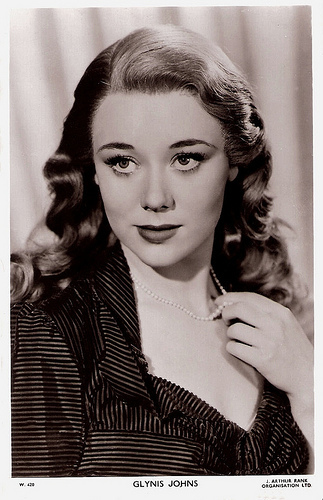
British postcard in the Picturegoer series, London, no. W 420. Photo: J. Arthur Rank Organisation LTD.
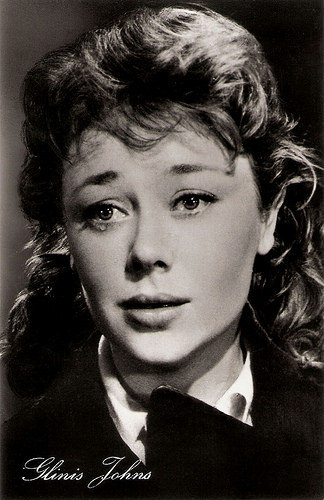
East-German postcard by VEB Progress Film-Vertrieb, Berlin, no. 1351, 1960. Photo: publicity still for Personal Affair (Anthony Pelissier, 1953).
Mary Poppins
During the 1960s, Glynis Johns often appeared on American television. She portrayed Kitty O'Moyne, an Irish immigrant in the TV crime drama The Roaring 20s (1961). In the 1962–1963 television season, Johns guest starred in the anthology series The Lloyd Bridges Show. She and Keith Andes then starred as a married couple in her eponymous television series Glynis (1963), in which she played a mystery writer and Andes a criminal defence attorney. The program was cancelled after thirteen episodes.
Her feature films include The Cabinet of Caligari (Roger Kay, 1962) and The Chapman Report (George Cukor, 1962). One of Glynis Johns’ best-known roles is Winifred Banks in Walt Disney’s fantasy Mary Poppins (Robert Stevenson, 1964), starring Julie Andrews. Winifred Banks is the easily distracted mother of the Banks family and is depicted as a member the suffragette movement.
On TV she was the villainess Lady Penelope Peasoup in the TV Series Batman (1967). She played with Richard Burton in the British film Under Milk Wood (Andrew Sinclair, 1972) based on the radio play of the same name by the Welsh writer Dylan Thomas.
Johns also appeared on stage, most memorably in the original Broadway production of Stephen Sondheim's musical A Little Night Music (1973). Stephen Sondheim wrote the song Send in the Clowns with shorter phrasing to accommodate her husky voice. Johns won a Tony award for her role in the musical.
At the West End in London, she appeared in the play Cause Célèbre (1978), by Terence Rattigan. During the first season of the hit TV sitcom Cheers (1983), Johns guest starred as the mother of Diane (Shelley Long), Helen Chambers. Due to a stipulation in Diane's late father's will, Helen, a rich eccentric, will lose all her money unless Diane is married by the next day.
From 1988-1989, Johns played Trudie Pepper, a senior citizen living in an Arizona retirement community, in the television sitcom Coming of Age. She also played opposite Rex Harrison in his final acting role in a Broadway revival of W. Somerset Maugham's play The Circle (1989-1990). Harrison's death from cancer ended the show's run.
In 1998, Johns starred as Myrtle Bledsoe in the premiere of Horton Foote's A Coffin in Egypt at the Bay Street Theatre. Her last film appearance to date was as Molly Shannon's grandmother in the comedy Superstar (Bruce McCulloch, 1999).
Glynis Johns has been married four times. Her first husband was Anthony Forwood (1942–1948), with whom she had her only child, Gareth Forwood (1945–2007), an actor, who predeceased his mother. Later, Anthony Forwood was Sir Dirk Bogarde's longtime partner and manager until Forwood's death in 1988. Johns’ other husbands were David Ramsey Foster (1952-1956), a chairman of Colgate Palmolive International, Cecil Peter L. Henderson (1960-1962) and the writer Elliot Arnold (1964-1973). Now a naturalised United States citizen, Johns currently resides in a quiet retirement complex in Los Angeles, California.
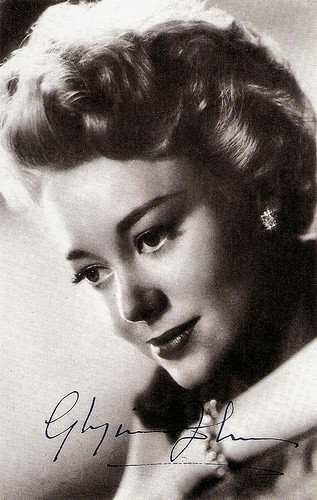
British postcard in the Film Star Autograph Portrait series by L.D. LTD., London, no. 66. Photo: J. Arthur Rank Organisation. Publicity still for The Seekers (Ken Annakin, 1954).
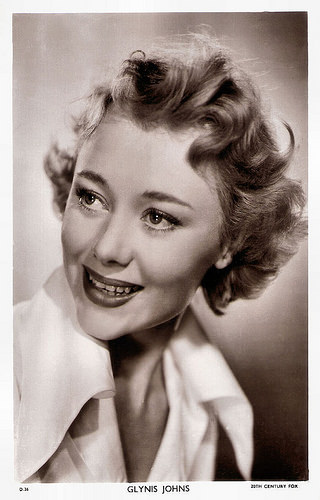
British postcard in the Picturegoer series, London, no. D 36. Photo: 20th Century Fox.
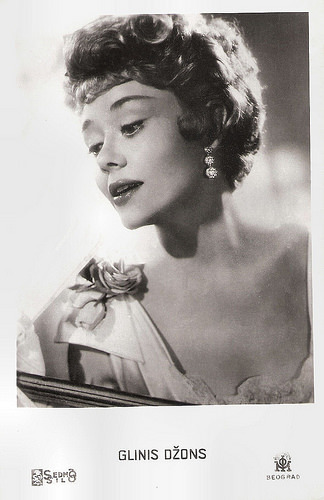
Yugoslavian postcard by Sedmo Silo / IOM, Beograd.
Sources: (IMDb), Film Reference, Wikipedia and .

British autograph card. Publicity still for An Ideal Husband (Alexander Korda, 1947).

Vintage card. Photo: publicity still for Rob Roy, The Highland Rogue (Harold French, 1953).
A playful mermaid
Glynis Margaret P. Johns was born in 1923 in Pretoria, South Africa. She was the daughter of pianist Alys Maude (née Steele-Payne), and the British stage and film actor Mervyn Johns. Her parents were performing on tour in Pretoria when Glynis was born.
Glynis attended Clifton High School in Bristol for a short time. In 1935, she made her first stage appearance in Buckie's Bears as a child ballerina.
She made her film debut in the Alexander Korda production South Riding (Victor Saville, 1938) with Edna Best. She had a supporting part in the British war drama 49th Parallel/The Invaders (1941), the third film made by the writer-director team of Michael Powell and Emeric Pressburger.
In 1944, she appeared with her father in the drama Halfway House (Basil Dearden, 1944) about ten people who are drawn to stay in an old hotel in a remote Welsh village. In 1948 she starred as a beautiful and playful mermaid in the comedy Miranda (Ken Annakin, 1948) and later reprised the role in the sequel, Mad About Men (Ralph Thomas, 1954).
In the aviation drama No Highway in the Sky/No Highway (Henry Koster, 1951) she co-starred with James Stewart and
Johns then made a successful transition to Hollywood, appearing in Personal Affair (Anthony Pelissier, 1953), starring Gene Tierney, and in The Court Jester (Melvin Frank, Norman Panama, 1956) as Danny Kaye's love interest. The following year, she starred in the Christmas film All Mine to Give (Allen Reisner, 1957). Johns received an Academy Award nomination for Best Supporting Actress for The Sundowners (Fred Zinnemann, 1960), starring Deborah Kerr and Robert Mitchum.

British postcard in the Picturegoer series, London, no. W 420. Photo: J. Arthur Rank Organisation LTD.

East-German postcard by VEB Progress Film-Vertrieb, Berlin, no. 1351, 1960. Photo: publicity still for Personal Affair (Anthony Pelissier, 1953).
Mary Poppins
During the 1960s, Glynis Johns often appeared on American television. She portrayed Kitty O'Moyne, an Irish immigrant in the TV crime drama The Roaring 20s (1961). In the 1962–1963 television season, Johns guest starred in the anthology series The Lloyd Bridges Show. She and Keith Andes then starred as a married couple in her eponymous television series Glynis (1963), in which she played a mystery writer and Andes a criminal defence attorney. The program was cancelled after thirteen episodes.
Her feature films include The Cabinet of Caligari (Roger Kay, 1962) and The Chapman Report (George Cukor, 1962). One of Glynis Johns’ best-known roles is Winifred Banks in Walt Disney’s fantasy Mary Poppins (Robert Stevenson, 1964), starring Julie Andrews. Winifred Banks is the easily distracted mother of the Banks family and is depicted as a member the suffragette movement.
On TV she was the villainess Lady Penelope Peasoup in the TV Series Batman (1967). She played with Richard Burton in the British film Under Milk Wood (Andrew Sinclair, 1972) based on the radio play of the same name by the Welsh writer Dylan Thomas.
Johns also appeared on stage, most memorably in the original Broadway production of Stephen Sondheim's musical A Little Night Music (1973). Stephen Sondheim wrote the song Send in the Clowns with shorter phrasing to accommodate her husky voice. Johns won a Tony award for her role in the musical.
At the West End in London, she appeared in the play Cause Célèbre (1978), by Terence Rattigan. During the first season of the hit TV sitcom Cheers (1983), Johns guest starred as the mother of Diane (Shelley Long), Helen Chambers. Due to a stipulation in Diane's late father's will, Helen, a rich eccentric, will lose all her money unless Diane is married by the next day.
From 1988-1989, Johns played Trudie Pepper, a senior citizen living in an Arizona retirement community, in the television sitcom Coming of Age. She also played opposite Rex Harrison in his final acting role in a Broadway revival of W. Somerset Maugham's play The Circle (1989-1990). Harrison's death from cancer ended the show's run.
In 1998, Johns starred as Myrtle Bledsoe in the premiere of Horton Foote's A Coffin in Egypt at the Bay Street Theatre. Her last film appearance to date was as Molly Shannon's grandmother in the comedy Superstar (Bruce McCulloch, 1999).
Glynis Johns has been married four times. Her first husband was Anthony Forwood (1942–1948), with whom she had her only child, Gareth Forwood (1945–2007), an actor, who predeceased his mother. Later, Anthony Forwood was Sir Dirk Bogarde's longtime partner and manager until Forwood's death in 1988. Johns’ other husbands were David Ramsey Foster (1952-1956), a chairman of Colgate Palmolive International, Cecil Peter L. Henderson (1960-1962) and the writer Elliot Arnold (1964-1973). Now a naturalised United States citizen, Johns currently resides in a quiet retirement complex in Los Angeles, California.

British postcard in the Film Star Autograph Portrait series by L.D. LTD., London, no. 66. Photo: J. Arthur Rank Organisation. Publicity still for The Seekers (Ken Annakin, 1954).

British postcard in the Picturegoer series, London, no. D 36. Photo: 20th Century Fox.

Yugoslavian postcard by Sedmo Silo / IOM, Beograd.
Sources: (IMDb), Film Reference, Wikipedia and .
Published on January 29, 2017 22:00
January 28, 2017
Emmanuelle Riva (1927–2017)
On Friday 27 January 2017, French actress Emmanuelle Riva passed away at the age of 89. She became well-known for her roles in the classic Nouveau Vague films Hiroshima mon amour (1959) and Léon Morin, prêtre (1961). In her 80s, Emmanuelle Riva became an icon for world cinema all over again with Michael Haneke's Amour (2012). Riva received both the Bafta and the César award for her role as the retired music teacher Anne in Amour. She was also nominated for an Oscar for her touching performance.
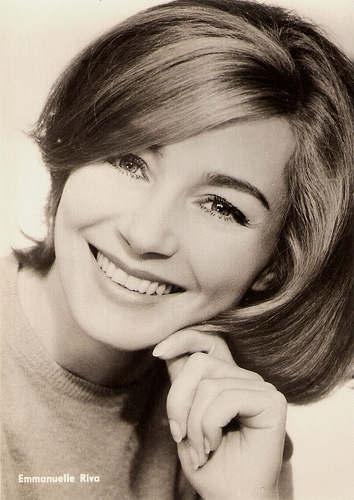
East-German postcard by VEB Progress Filvertrieb, Berlin, no. 1269, 1969. Retail price: 0,20 M. Photo: Unifrance Film. Publicity still for Berufsrisiko/Les risques du métier (André Cayatte, 1967).
Elle
Emmanuelle Riva was born Paulette Germaine Riva in Cheniménil in eastern France in 1927. She was the only child of Jeanne Riva née Nourdin and Alfredo Riva, an Italian born sign painter.
From the age of 6, Emmanuelle dreamed about becoming an actress, and appeared in various school plays and amateur dramatics groups. For a provincial girl, from a modest family with no connection to the world of theatre or cinema, the theatre seemed an impossible ambition. She worked as a seamstress.
At the age of 26, Riva moved to Paris where she studied at the Dramatic Arts Centre of Rue Blanche. She made her stage debut in George Bernard Shaw’s Arms and the Man. Further classical roles followed in Mrs Warren’s Profession (Shaw), L’Espoir (Henri Bernstein), Le Dialogue des Carmélites (Georges Bernanos), and Britannicus (Jean Racine).
She made her screen debut on television playing the Queen of England in the historical anthology series Enigmas de L’Histoire/Enigmas of History (1956-1957). The following year she made her first film appearance with an uncredited role in Les grandes familles/The Possessors (Denys de la Patellière, 1958) starring Jean Gabin .
The following year she acted in the Dominique Rolin play L'Epouvantail (The Scarecrow) at the Théatre de L'Oeuvre in Paris. She was visited in her dressing room by young documentary film maker who had directed only a few shorts and documentaries, Alain Resnais.
Resnais offered her the female lead, Elle, in his first feature film Hiroshima mon amour/Hiroshima My Love (Alain Resnais, 1959) written by Marguerite Duras. Riva played an unnamed French woman - Elle translates as She - talking to her young Japanese lover about the bombing of Hiroshima, about memory and forgetfulness. Riva’s powerful, haunting performance helped the film to become a huge art-house hit. For her role she was nominated for a Bafta Award in 1960. Hiroshima mon amour was also a catalyst for the Nouvelle Vague, the French New Wave, innovatively using miniature flashbacks to create a uniquely nonlinear storyline.
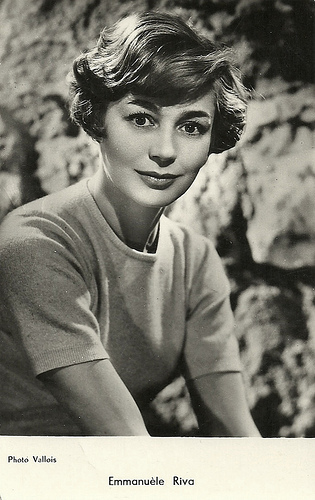
French postcard by Editions P.I., Paris, no. 1088. Presented by Les Carbones Korès 'Carboplane'. Photo: Studio Vallois.
Tormented by unrequited love
In the following years, Emmanuelle Riva appeared in critically acclaimed roles in films like the Oscar nominated Holocaust drama Kapò (Gillo Pontecorvo, 1959), and the comedy Adua e le compagne/Adua and her Friends (Antonio Pietrangeli, 1960) as Simone Signoret 's feisty friend.
In Léon Morin, prêtre/Leon Morin, Priest (Jean-Pierre Melville, 1961) she played an atheist widow in a sexually charged friendship with a priest played by Jean-Paul Belmondo .
James Travers in his review at Films de France : “What makes this such a compelling film are the extraordinary performances from its two lead actors, Jean-Paul Belmondo and Emmanuelle Riva. (...) Riva’s portrayal of a woman tormented by unrequited love is equally arresting and gives the film its harrowing realism and poignancy. Both performances are complemented by the film’s austere realist design, the bleakness of the wartime setting underlined by the work of Melville’s trusted cinematographer Henri Decaë. Léon Morin, prêtre is a powerfully moving study in desire and moral conflict, arguably the darkest and most unsettling of all Jean-Pierre Melville’s films.”
Riva then won the Volpi Cup for best actress at the Venice Film Festival 1962 for her role as an unhappily married provincial wife who poisons her husband in Thérèse Desqueyroux (Georges Franju, 1962).
She worked with director Georges Franju again on the Jean Cocteau adaptation Thomas l'imposteur/Thomas the Imposter (Georges Franju, 1965). These were all European, mostly French films. Riva spoke French and some Italian but did not speak English and never performed in English.
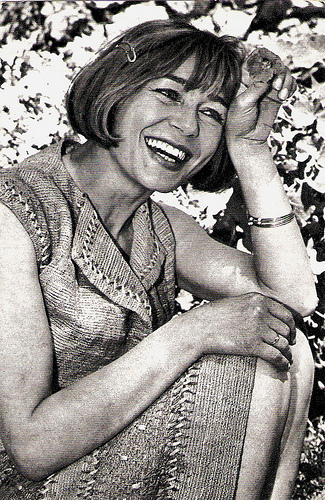
Romanian postcard by Casa Filmului Acin, no. 177.
An extraordinary career renaissance
Emmanuelle Riva turned down many ‘commercial’ roles and producers stopped calling. Through the years, she enjoyed an extensive theatre career in Paris. In 2001, her last stage appearance was in a production of Medea at Odéon-Théâtre de l'Europe.
She appeared occasionally on French television programs, published poems and was also a skilled photographer. When she was in Japan to shoot Hiroshima, mon amour (1959), she bought a Ricohflex and began to take photos of people. In 2008, these photographs were exhibited at the Nikon Salon and were issued in the book Tu n'as rien vu à Hiroshima (You have seen nothing in Hiroshima).
She continued to appear in respectable films like Les risques du métier/Risky Business (André Cayatte, 1967) as the co-star of Jacques Brel , Gli occhi, la bocca/The Eyes, the Mouth (Marco Bellocchio, 1982) as a deeply religious mother whose son (Lou Castel) attempts to shield her from the truth about the death of his twin brother, Liberté, la nuit/Freedom, the night (Philippe Garrel, 1983) as the estranged wife of a revolutionary (Maurice Garrel), and Trois Couleurs: Bleu/Three Colours: Blue (Krzysztof Kieślowski, 1983) as the mother of Juliette Binoche.
In 1999 she appeared alongside Micheline Presle in Vénus beauté (institut)/Venus Beauty Institute (Tonie Marshall, 1999), and in 2011 in Le Skylab, starring and directed by Julie Delpy.
The following year she had an extraordinary career renaissance with her role as retired piano teacher Anne Laurent in Amour (2012, Michael Haneke). Anne lives in a chic Paris apartment with her husband, Georges ( Jean-Louis Trintignant ), until a series of strokes spark dementia, physical disability and a slow dismantling of her body and mind.
The film got rave reviews and won the Palme d’Or at the Cannes Film Festival. Riva won for her role both the Bafta Award and the César Award for best actress. She was also nominated for an Academy Award for best actress - the oldest actress ever to be so. The 85th Academy Awards were held on her 86th birthday, but she lost out to Jennifer Lawrence.
Emmanuelle Riva died from cancer on 27 January 2017 in Paris at the age of 89. She was never married and did not have children.
Trailer Hiroshima mon amour/Hiroshima My Love (1959). Source: Criterion Collection (YouTube).
Trailer Léon Morin, prêtre/Leon Morin, Priest (1961). Source: neondreams 25 (YouTube).
Trailer Amour (2012). Source: @HOLLYWOOD (YouTube).
Sources: James Travers (Films de France), Kim Willsher (The Observer), (IMDb), New Wave Film.com, Wikipedia, and .

East-German postcard by VEB Progress Filvertrieb, Berlin, no. 1269, 1969. Retail price: 0,20 M. Photo: Unifrance Film. Publicity still for Berufsrisiko/Les risques du métier (André Cayatte, 1967).
Elle
Emmanuelle Riva was born Paulette Germaine Riva in Cheniménil in eastern France in 1927. She was the only child of Jeanne Riva née Nourdin and Alfredo Riva, an Italian born sign painter.
From the age of 6, Emmanuelle dreamed about becoming an actress, and appeared in various school plays and amateur dramatics groups. For a provincial girl, from a modest family with no connection to the world of theatre or cinema, the theatre seemed an impossible ambition. She worked as a seamstress.
At the age of 26, Riva moved to Paris where she studied at the Dramatic Arts Centre of Rue Blanche. She made her stage debut in George Bernard Shaw’s Arms and the Man. Further classical roles followed in Mrs Warren’s Profession (Shaw), L’Espoir (Henri Bernstein), Le Dialogue des Carmélites (Georges Bernanos), and Britannicus (Jean Racine).
She made her screen debut on television playing the Queen of England in the historical anthology series Enigmas de L’Histoire/Enigmas of History (1956-1957). The following year she made her first film appearance with an uncredited role in Les grandes familles/The Possessors (Denys de la Patellière, 1958) starring Jean Gabin .
The following year she acted in the Dominique Rolin play L'Epouvantail (The Scarecrow) at the Théatre de L'Oeuvre in Paris. She was visited in her dressing room by young documentary film maker who had directed only a few shorts and documentaries, Alain Resnais.
Resnais offered her the female lead, Elle, in his first feature film Hiroshima mon amour/Hiroshima My Love (Alain Resnais, 1959) written by Marguerite Duras. Riva played an unnamed French woman - Elle translates as She - talking to her young Japanese lover about the bombing of Hiroshima, about memory and forgetfulness. Riva’s powerful, haunting performance helped the film to become a huge art-house hit. For her role she was nominated for a Bafta Award in 1960. Hiroshima mon amour was also a catalyst for the Nouvelle Vague, the French New Wave, innovatively using miniature flashbacks to create a uniquely nonlinear storyline.

French postcard by Editions P.I., Paris, no. 1088. Presented by Les Carbones Korès 'Carboplane'. Photo: Studio Vallois.
Tormented by unrequited love
In the following years, Emmanuelle Riva appeared in critically acclaimed roles in films like the Oscar nominated Holocaust drama Kapò (Gillo Pontecorvo, 1959), and the comedy Adua e le compagne/Adua and her Friends (Antonio Pietrangeli, 1960) as Simone Signoret 's feisty friend.
In Léon Morin, prêtre/Leon Morin, Priest (Jean-Pierre Melville, 1961) she played an atheist widow in a sexually charged friendship with a priest played by Jean-Paul Belmondo .
James Travers in his review at Films de France : “What makes this such a compelling film are the extraordinary performances from its two lead actors, Jean-Paul Belmondo and Emmanuelle Riva. (...) Riva’s portrayal of a woman tormented by unrequited love is equally arresting and gives the film its harrowing realism and poignancy. Both performances are complemented by the film’s austere realist design, the bleakness of the wartime setting underlined by the work of Melville’s trusted cinematographer Henri Decaë. Léon Morin, prêtre is a powerfully moving study in desire and moral conflict, arguably the darkest and most unsettling of all Jean-Pierre Melville’s films.”
Riva then won the Volpi Cup for best actress at the Venice Film Festival 1962 for her role as an unhappily married provincial wife who poisons her husband in Thérèse Desqueyroux (Georges Franju, 1962).
She worked with director Georges Franju again on the Jean Cocteau adaptation Thomas l'imposteur/Thomas the Imposter (Georges Franju, 1965). These were all European, mostly French films. Riva spoke French and some Italian but did not speak English and never performed in English.

Romanian postcard by Casa Filmului Acin, no. 177.
An extraordinary career renaissance
Emmanuelle Riva turned down many ‘commercial’ roles and producers stopped calling. Through the years, she enjoyed an extensive theatre career in Paris. In 2001, her last stage appearance was in a production of Medea at Odéon-Théâtre de l'Europe.
She appeared occasionally on French television programs, published poems and was also a skilled photographer. When she was in Japan to shoot Hiroshima, mon amour (1959), she bought a Ricohflex and began to take photos of people. In 2008, these photographs were exhibited at the Nikon Salon and were issued in the book Tu n'as rien vu à Hiroshima (You have seen nothing in Hiroshima).
She continued to appear in respectable films like Les risques du métier/Risky Business (André Cayatte, 1967) as the co-star of Jacques Brel , Gli occhi, la bocca/The Eyes, the Mouth (Marco Bellocchio, 1982) as a deeply religious mother whose son (Lou Castel) attempts to shield her from the truth about the death of his twin brother, Liberté, la nuit/Freedom, the night (Philippe Garrel, 1983) as the estranged wife of a revolutionary (Maurice Garrel), and Trois Couleurs: Bleu/Three Colours: Blue (Krzysztof Kieślowski, 1983) as the mother of Juliette Binoche.
In 1999 she appeared alongside Micheline Presle in Vénus beauté (institut)/Venus Beauty Institute (Tonie Marshall, 1999), and in 2011 in Le Skylab, starring and directed by Julie Delpy.
The following year she had an extraordinary career renaissance with her role as retired piano teacher Anne Laurent in Amour (2012, Michael Haneke). Anne lives in a chic Paris apartment with her husband, Georges ( Jean-Louis Trintignant ), until a series of strokes spark dementia, physical disability and a slow dismantling of her body and mind.
The film got rave reviews and won the Palme d’Or at the Cannes Film Festival. Riva won for her role both the Bafta Award and the César Award for best actress. She was also nominated for an Academy Award for best actress - the oldest actress ever to be so. The 85th Academy Awards were held on her 86th birthday, but she lost out to Jennifer Lawrence.
Emmanuelle Riva died from cancer on 27 January 2017 in Paris at the age of 89. She was never married and did not have children.
Trailer Hiroshima mon amour/Hiroshima My Love (1959). Source: Criterion Collection (YouTube).
Trailer Léon Morin, prêtre/Leon Morin, Priest (1961). Source: neondreams 25 (YouTube).
Trailer Amour (2012). Source: @HOLLYWOOD (YouTube).
Sources: James Travers (Films de France), Kim Willsher (The Observer), (IMDb), New Wave Film.com, Wikipedia, and .
Published on January 28, 2017 22:00
January 27, 2017
Werner Krauss
German stage and film actor Werner Krauss (1884-1959) became a worldwide sensation as the demonic Dr. Caligari in the classic of the German expressionist cinema, Das Kabinett des Doktor Caligari/The Cabinet of Dr. Caligari (1919). He appeared in several silent masterpieces, but his magnificent film career was later overshadowed by his appearance in one of the most notorious propaganda films of the Third Reich.
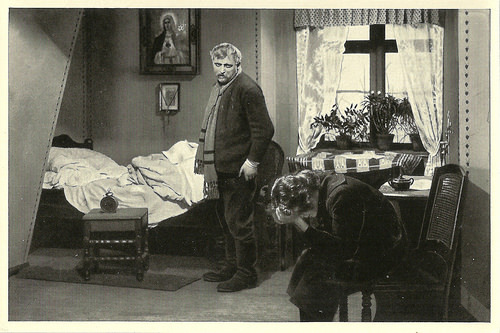
German photocard for the album Vom Werden Deutscher Filmkunst by Ross Verlag. Photo: Ufa. Werner Krauss in the classic German Kammerspiel film Scherben/Shattered (Lupu Pick, 1921). The woman is Edith Posca, who plays the daughter.
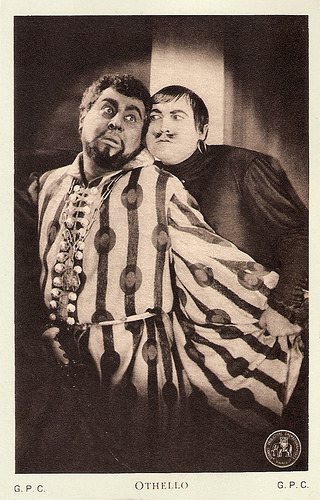
French postcard by Edition de la Cinématographie-Française, Paris. Photo: G.P.C. Publicity still for Othello (Dimitri Buchowetzki, 1922) with Emil Jannings as Othello.
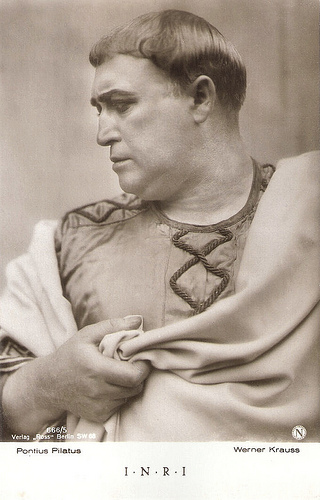
German postcard by Ross Verlag G.m.b.H., Berlin, no. 666/5, 1919-1924. Photo: Neumann-Filmproduktion. Publicity still for I.N.R.I./Crown of Thorns (Robert Wiene, 1923). Caption: Pontius Pilatus.
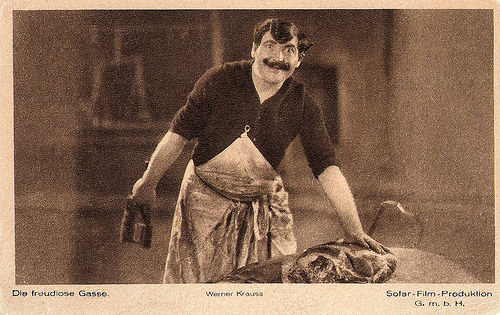
German postcard by Ross Verlag G.m.b.H., Berlin. Photo: Sofar-Film-Produktion. Publicity still for Die freudlose Gasse/The Joyless Street (Georg Wilhelm Pabst, 1925).
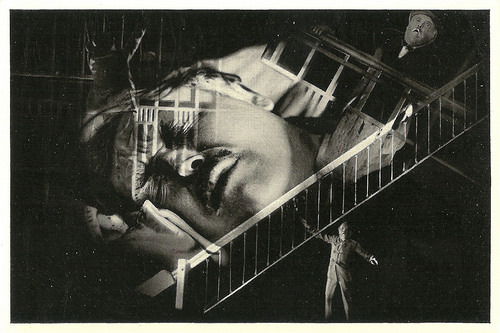
German photocard for the album Vom Werden Deutscher Filmkunst by Ross Verlag. Photo: Ufa. Werner Krauss in Geheimnisse einer Seele/Secrets of a Soul (G.W. Pabst, 1926).
Worldwide Sensation
Werner Johannes Krauss (Krauß in German) was born in Gestungshausen, Germany, in 1884. He was the son of a clergyman. He ran away from home and joined a travelling theatre company.
In Berlin he became a film actor. Among his first films were Die Pagode/The Pagoda (Joe May, 1914), Nächte des Grauens/A Night of Horror (Richard Oswald, Arthur Robison, 1916) with Emil Jannings , Hoffmanns Erzählungen/Tales of Hoffmann (Richard Oswald, 1916) and Opium (Robert Reinert, 1919) with Conrad Veidt .
In 1916, he met the noted theatre director Max Reinhardt and went to work for him. Krauss had been trained to do exaggerated gestures for the stage, and the German expressionist cinema was but a short stylistic step further for him.
In 1919, he became a worldwide sensation for his demonic portrayal of Dr. Caligari in Robert Wiene's Das Kabinett des Dr. Caligari/The Cabinet of Dr. Caligari (1919). Dr. Caligari is a a sinister hypnotist who travels the carnival circuit displaying a somnambulist named Cesare ( Conrad Veidt ). In one tiny German town, a series of murders coincides with Caligari's visit. Krauss was just 35 at the time he appeared in the film, but his heavy makeup made him seem older.
Doug Tomlinson at Film Reference : “In The Cabinet of Dr. Caligari Krauss epitomizes the German Expressionist performance aesthetic which would dominate the next decade: an obvious external expression of interiority. Throughout the central part of the film, Krauss hobbles through nightmare sets, his crippled walk an expression of a crippled mind, his dark and menacing facial and body makeup of the rot within, his sparse and erratic white hair of his overall decrepitude. His posture, rounded inward to symbolize mystery and enclosure, refuses the spectator any sympathetic identification. At the film's end, when Caligari is shown to be the head of an asylum and the film the rantings of an inmate, Krauss expressionistically softens all aspects of posture and characterization to appear the epitome of benevolence.“
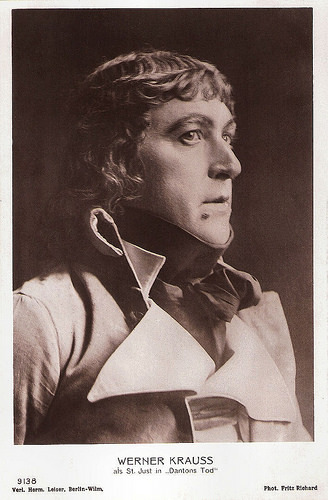
German postcard by Verlag Hermann Leiser, Berlin, no. 9138. Photo: Fritz Richard. Publicity for the stage play Dantons Tod (the Death of Danton) with Werner Krauss as St. Just.
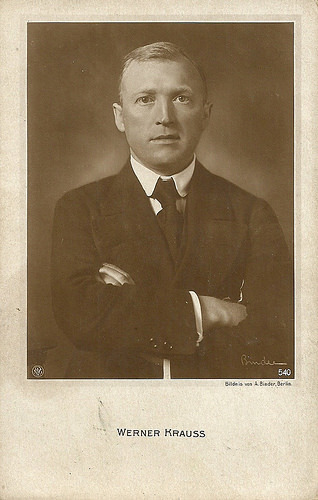
German postcard by NPG, no. 540. Photo: Alex Binder, Berlin.
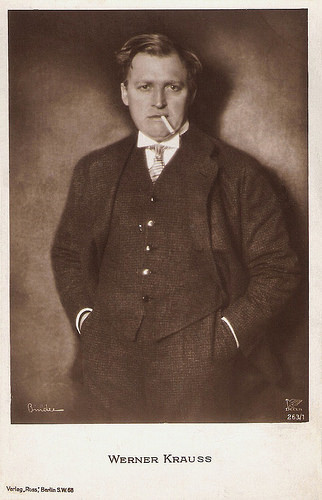
German postcard by Ross Verlag, Berlin, no. 263/1, 1919-1924.Photo: Alex Binder / Decla.
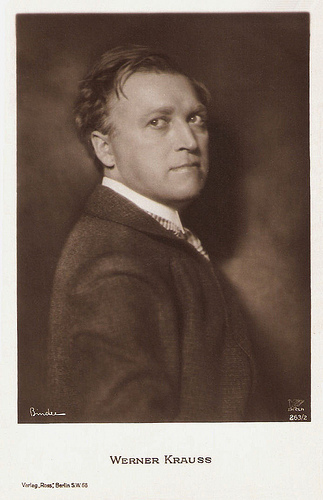
German postcard by Ross Verlag, Berlin, no. 263/2, 1919-1924. Photo: Alex Binder / Decla.
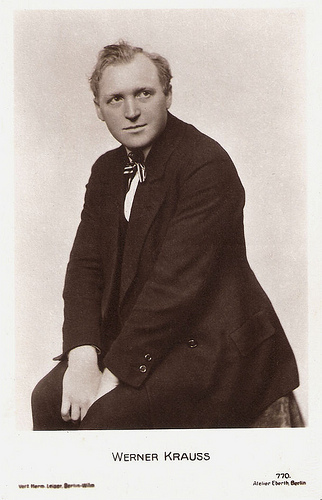
German postcard by Verlag Hermann Leiser, Berlin-Wilm., no. 770. Photo: Eberth, Berlin.
A Smorgasbord of Visual Delights
Werner Krauss’ heavy, declamatory technique was perfect for such roles as Bottom in Ein Sommernachtstraum/A Midsummer Night's Dream (Hans Neumann, 1924) and Jack the Ripper in Das Wachsfigurenkabinett/The Wax Works (Paul Leni, 1924) opposite Emil Jannings and Conrad Veidt .
He also played Iago in a 1922 adaptation of William Shakespeare's Othello (Dimitri Buchowetzki, 1922). Hal Erickson writes at AllMovie : “Even without the benefit of sound, the 1922 German adaptation of Othello seems more operatic than Shakespearean. This may be due to the casting of Emil Jannings , to whom restraint and subtlety were strangers. Werner Krauss, of Cabinet of Dr. Caligari fame, is on hand as the duplicitous Iago. Appearing as the unfortunate Desdemona is Lea Von Lenkeffy, better known as Lya de Putti . Produced on an elaborate scale, Othello may not be true to the letter of Shakespeare, but is undeniably a smorgasbord of visual delights.”
Krauss was again prominently featured in such silent masterpieces as Varieté/Jealousy (Ewald André Dupont, 1925), Herr Tartüff/Tartuffe (F.W. Murnau, 1925) based on the classic Molière play, and Der Student von Prag/The Man Who Cheated Life (Henrik Galeen, 1926).
He also worked internationally. In France he appeared as the obsessed Count Muffat in Jean Renoir's version of Emile Zola's Nana (Jean Renoir, 1926). Totally submissive to the demands of the exploitative Nana, he ultimately disgraces himself by barking, sitting, rolling over, and playing dead like a dog. His utterly degraded character is reflected in his lumpish posture.
By 1926, Krauss had worked with such major directors as F.W. Murnau, G.W. Pabst, Lupu Pick, E. A. Dupont, Richard Oswald, Paul Leni, and Jean Renoir. He was one of the leading German film actors of his time, but his obsessed and evil characters became more and more a cliché.
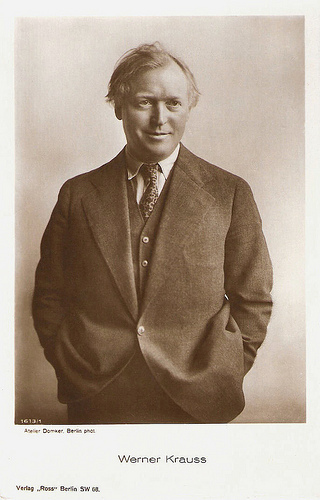
German postcard by Ross Verlag, Berlin, no. 1613/1, 1927-1928. Photo: Atelier Domker, Berlin.
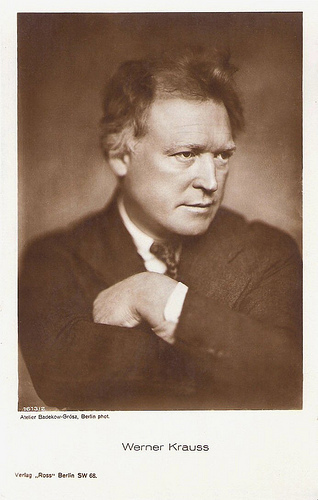
German postcard by Ross Verlag, Berlin, no. 1613/2, 1927-1928. Photo: Atelier Badekow-Grósz, Berlin.
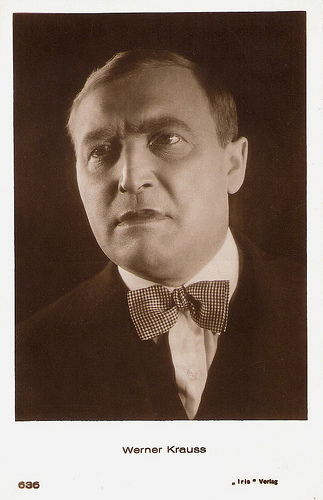
Austrian postcard by Iris Verlag, no. 636.
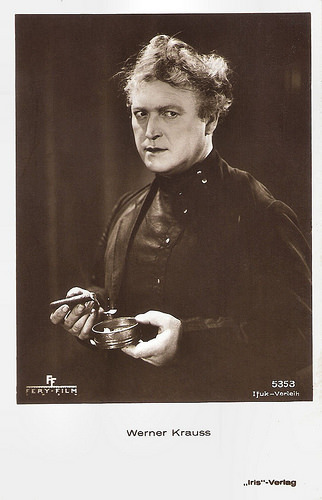
Austrian postcard by Iris-Verlag, no. 5353. Photo: Fery-Film / Ifuk-Verleih. Publicity still for Der fidele Bauer/The Merry Farmer (Franz Seitz, 1929).
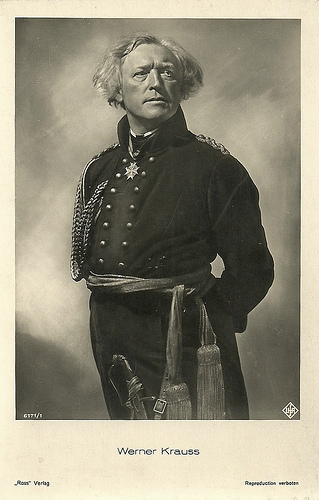
German postcard by Ross Verlag, no. 6171/1, 1930-1931. Photo: Ufa. Werner Krauss as the title character in Yorck (Gustav Ucicky, 1931).
Actor of the State
When Adolf Hitler came to power, Werner Krauss clutched the Nazi ideology firmly to his bosom. He only incidentally played in films such as the charming Burgtheater/Burg Theatre (Willi Forst, 1936) with Olga Tschechova .
He was made an Actor of the State by Reich Minister of Propaganda Joseph Goebbels, and subsequently played the roles of two stereotypical Jewish characters – Rabbi Loew and Sekretar Levy – in Veit Harlan 's notoriously antisemitic Jud Süß/Jew Süss (Veit Harlan, 1940).
Hal Erickson writes in his review of the film at AllMovie : “Lion Feuchtwangler's novel Jud Süss was originally about a powerful ghetto businessman who believes himself to be a Jew. Süss's ruthless business practices result in the betrayal of an innocent girl, for which he is arrested and sentenced to be hanged under the anti-Jewish laws of the 18th century. While he waits to be executed, Süss discovers he is not Jewish. Rather than turn his back on the people of the ghetto with whom he'd grown up, Süss courageously refuses to declare his 'Aryan' status, even though it means he will die on the gallows. The Feuchtwangler book was designed in roundabout fashion to strike a blow against anti-Semitism. But when Jud Süss was filmed in Germany at the behest of Nazi propaganda minister Joseph Goebbels in 1940, its original message was twisted and perverted into an argument in favor of 'ethnic cleansing'.”
Krauss also played Shylock in an extreme production of The Merchant of Venice staged at Vienna's Burgtheater in 1943. After World War II, all associated with Jud Süss were plagued with recriminations for their participation, which drove Krauss out of the country for more than three years.
Leading German democrats registered emphatic opposition to public appearances by him. In June of 1954, one of West Germany's highest decorations was ceremoniously conferred on him by West Berlin's cultural and education chief.
The actor appeared in only three more films before his death. His final film was the Heimatfilm Sohn Ohne Heimat/Son Without a Homeland (Hans Deppe, 1955).
Werner Krauss died in relative obscurity in Vienna, Austria in 1959. He was married to Marie Bard who died in 1944.
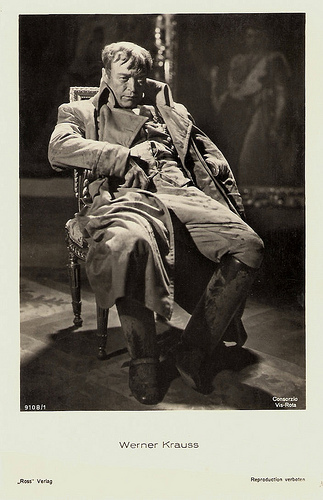
German postcard by Ross Verlag, no. 9108/1, 1935-1936. Photo: Consorzio Vis / Rota. Publicity still for Hundert Tage/Hundred Days (Franz Wenzler, 1935) with Werner Krauss as Napoleon.
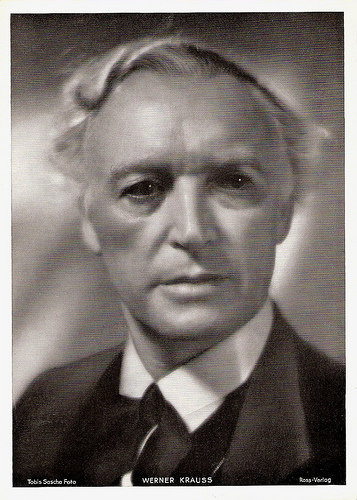
Big German card by Ross Verlag, Berlin. Photo: Tobis Sascha foto.
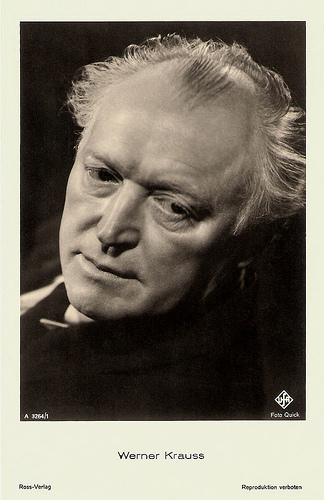
German postcard by Ross Verlag, Berlin, no. A 3264/1, 1941-1944. Photo: Foto Quick / Ufa.
Trailer Das Kabinett des Doktor Caligari/The Cabinet of Dr. Caligari (1919). Source: Movieclips Trailer Vault (YouTube).
Scene from Geheimnisse einer Seele/Secrets of a soul (1926). Source: sangrecoagulada (YouTube).
Sources: Hal Erickson (AllMovie), Doug Tomlinson (Film Reference), Katzizkidz (Find A Grave), Wikipedia, and .

German photocard for the album Vom Werden Deutscher Filmkunst by Ross Verlag. Photo: Ufa. Werner Krauss in the classic German Kammerspiel film Scherben/Shattered (Lupu Pick, 1921). The woman is Edith Posca, who plays the daughter.

French postcard by Edition de la Cinématographie-Française, Paris. Photo: G.P.C. Publicity still for Othello (Dimitri Buchowetzki, 1922) with Emil Jannings as Othello.

German postcard by Ross Verlag G.m.b.H., Berlin, no. 666/5, 1919-1924. Photo: Neumann-Filmproduktion. Publicity still for I.N.R.I./Crown of Thorns (Robert Wiene, 1923). Caption: Pontius Pilatus.

German postcard by Ross Verlag G.m.b.H., Berlin. Photo: Sofar-Film-Produktion. Publicity still for Die freudlose Gasse/The Joyless Street (Georg Wilhelm Pabst, 1925).

German photocard for the album Vom Werden Deutscher Filmkunst by Ross Verlag. Photo: Ufa. Werner Krauss in Geheimnisse einer Seele/Secrets of a Soul (G.W. Pabst, 1926).
Worldwide Sensation
Werner Johannes Krauss (Krauß in German) was born in Gestungshausen, Germany, in 1884. He was the son of a clergyman. He ran away from home and joined a travelling theatre company.
In Berlin he became a film actor. Among his first films were Die Pagode/The Pagoda (Joe May, 1914), Nächte des Grauens/A Night of Horror (Richard Oswald, Arthur Robison, 1916) with Emil Jannings , Hoffmanns Erzählungen/Tales of Hoffmann (Richard Oswald, 1916) and Opium (Robert Reinert, 1919) with Conrad Veidt .
In 1916, he met the noted theatre director Max Reinhardt and went to work for him. Krauss had been trained to do exaggerated gestures for the stage, and the German expressionist cinema was but a short stylistic step further for him.
In 1919, he became a worldwide sensation for his demonic portrayal of Dr. Caligari in Robert Wiene's Das Kabinett des Dr. Caligari/The Cabinet of Dr. Caligari (1919). Dr. Caligari is a a sinister hypnotist who travels the carnival circuit displaying a somnambulist named Cesare ( Conrad Veidt ). In one tiny German town, a series of murders coincides with Caligari's visit. Krauss was just 35 at the time he appeared in the film, but his heavy makeup made him seem older.
Doug Tomlinson at Film Reference : “In The Cabinet of Dr. Caligari Krauss epitomizes the German Expressionist performance aesthetic which would dominate the next decade: an obvious external expression of interiority. Throughout the central part of the film, Krauss hobbles through nightmare sets, his crippled walk an expression of a crippled mind, his dark and menacing facial and body makeup of the rot within, his sparse and erratic white hair of his overall decrepitude. His posture, rounded inward to symbolize mystery and enclosure, refuses the spectator any sympathetic identification. At the film's end, when Caligari is shown to be the head of an asylum and the film the rantings of an inmate, Krauss expressionistically softens all aspects of posture and characterization to appear the epitome of benevolence.“

German postcard by Verlag Hermann Leiser, Berlin, no. 9138. Photo: Fritz Richard. Publicity for the stage play Dantons Tod (the Death of Danton) with Werner Krauss as St. Just.

German postcard by NPG, no. 540. Photo: Alex Binder, Berlin.

German postcard by Ross Verlag, Berlin, no. 263/1, 1919-1924.Photo: Alex Binder / Decla.

German postcard by Ross Verlag, Berlin, no. 263/2, 1919-1924. Photo: Alex Binder / Decla.

German postcard by Verlag Hermann Leiser, Berlin-Wilm., no. 770. Photo: Eberth, Berlin.
A Smorgasbord of Visual Delights
Werner Krauss’ heavy, declamatory technique was perfect for such roles as Bottom in Ein Sommernachtstraum/A Midsummer Night's Dream (Hans Neumann, 1924) and Jack the Ripper in Das Wachsfigurenkabinett/The Wax Works (Paul Leni, 1924) opposite Emil Jannings and Conrad Veidt .
He also played Iago in a 1922 adaptation of William Shakespeare's Othello (Dimitri Buchowetzki, 1922). Hal Erickson writes at AllMovie : “Even without the benefit of sound, the 1922 German adaptation of Othello seems more operatic than Shakespearean. This may be due to the casting of Emil Jannings , to whom restraint and subtlety were strangers. Werner Krauss, of Cabinet of Dr. Caligari fame, is on hand as the duplicitous Iago. Appearing as the unfortunate Desdemona is Lea Von Lenkeffy, better known as Lya de Putti . Produced on an elaborate scale, Othello may not be true to the letter of Shakespeare, but is undeniably a smorgasbord of visual delights.”
Krauss was again prominently featured in such silent masterpieces as Varieté/Jealousy (Ewald André Dupont, 1925), Herr Tartüff/Tartuffe (F.W. Murnau, 1925) based on the classic Molière play, and Der Student von Prag/The Man Who Cheated Life (Henrik Galeen, 1926).
He also worked internationally. In France he appeared as the obsessed Count Muffat in Jean Renoir's version of Emile Zola's Nana (Jean Renoir, 1926). Totally submissive to the demands of the exploitative Nana, he ultimately disgraces himself by barking, sitting, rolling over, and playing dead like a dog. His utterly degraded character is reflected in his lumpish posture.
By 1926, Krauss had worked with such major directors as F.W. Murnau, G.W. Pabst, Lupu Pick, E. A. Dupont, Richard Oswald, Paul Leni, and Jean Renoir. He was one of the leading German film actors of his time, but his obsessed and evil characters became more and more a cliché.

German postcard by Ross Verlag, Berlin, no. 1613/1, 1927-1928. Photo: Atelier Domker, Berlin.

German postcard by Ross Verlag, Berlin, no. 1613/2, 1927-1928. Photo: Atelier Badekow-Grósz, Berlin.

Austrian postcard by Iris Verlag, no. 636.

Austrian postcard by Iris-Verlag, no. 5353. Photo: Fery-Film / Ifuk-Verleih. Publicity still for Der fidele Bauer/The Merry Farmer (Franz Seitz, 1929).

German postcard by Ross Verlag, no. 6171/1, 1930-1931. Photo: Ufa. Werner Krauss as the title character in Yorck (Gustav Ucicky, 1931).
Actor of the State
When Adolf Hitler came to power, Werner Krauss clutched the Nazi ideology firmly to his bosom. He only incidentally played in films such as the charming Burgtheater/Burg Theatre (Willi Forst, 1936) with Olga Tschechova .
He was made an Actor of the State by Reich Minister of Propaganda Joseph Goebbels, and subsequently played the roles of two stereotypical Jewish characters – Rabbi Loew and Sekretar Levy – in Veit Harlan 's notoriously antisemitic Jud Süß/Jew Süss (Veit Harlan, 1940).
Hal Erickson writes in his review of the film at AllMovie : “Lion Feuchtwangler's novel Jud Süss was originally about a powerful ghetto businessman who believes himself to be a Jew. Süss's ruthless business practices result in the betrayal of an innocent girl, for which he is arrested and sentenced to be hanged under the anti-Jewish laws of the 18th century. While he waits to be executed, Süss discovers he is not Jewish. Rather than turn his back on the people of the ghetto with whom he'd grown up, Süss courageously refuses to declare his 'Aryan' status, even though it means he will die on the gallows. The Feuchtwangler book was designed in roundabout fashion to strike a blow against anti-Semitism. But when Jud Süss was filmed in Germany at the behest of Nazi propaganda minister Joseph Goebbels in 1940, its original message was twisted and perverted into an argument in favor of 'ethnic cleansing'.”
Krauss also played Shylock in an extreme production of The Merchant of Venice staged at Vienna's Burgtheater in 1943. After World War II, all associated with Jud Süss were plagued with recriminations for their participation, which drove Krauss out of the country for more than three years.
Leading German democrats registered emphatic opposition to public appearances by him. In June of 1954, one of West Germany's highest decorations was ceremoniously conferred on him by West Berlin's cultural and education chief.
The actor appeared in only three more films before his death. His final film was the Heimatfilm Sohn Ohne Heimat/Son Without a Homeland (Hans Deppe, 1955).
Werner Krauss died in relative obscurity in Vienna, Austria in 1959. He was married to Marie Bard who died in 1944.

German postcard by Ross Verlag, no. 9108/1, 1935-1936. Photo: Consorzio Vis / Rota. Publicity still for Hundert Tage/Hundred Days (Franz Wenzler, 1935) with Werner Krauss as Napoleon.

Big German card by Ross Verlag, Berlin. Photo: Tobis Sascha foto.

German postcard by Ross Verlag, Berlin, no. A 3264/1, 1941-1944. Photo: Foto Quick / Ufa.
Trailer Das Kabinett des Doktor Caligari/The Cabinet of Dr. Caligari (1919). Source: Movieclips Trailer Vault (YouTube).
Scene from Geheimnisse einer Seele/Secrets of a soul (1926). Source: sangrecoagulada (YouTube).
Sources: Hal Erickson (AllMovie), Doug Tomlinson (Film Reference), Katzizkidz (Find A Grave), Wikipedia, and .
Published on January 27, 2017 22:00
January 26, 2017
Junie Astor
Junie Astor (1911-1967) was a French actress who was highly popular in the late 1930s. Her best known film is Jean Renoir's Les Bas-fonds/The Lower Depths (1936).
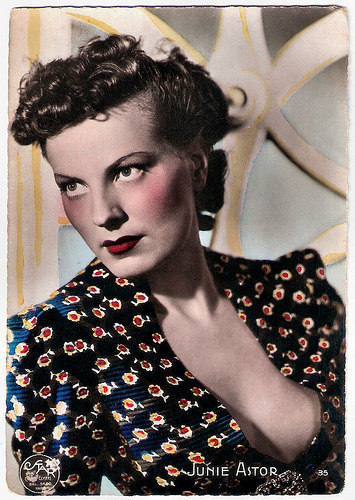
French postcard by Editions O.P., Paris, no. 35. Photo: Star, Paris.
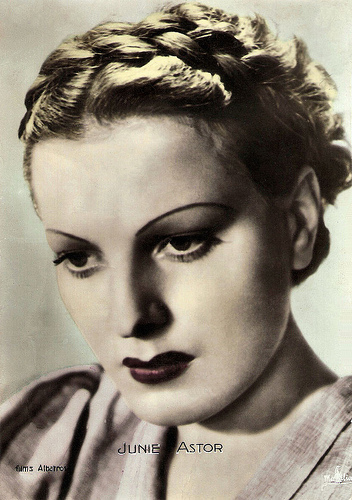
French postcard by Massilia. Photo: Filma Albatros. Publicity still for Les Bas-fonds/The Lower Depths (Jean Renoir, 1936).
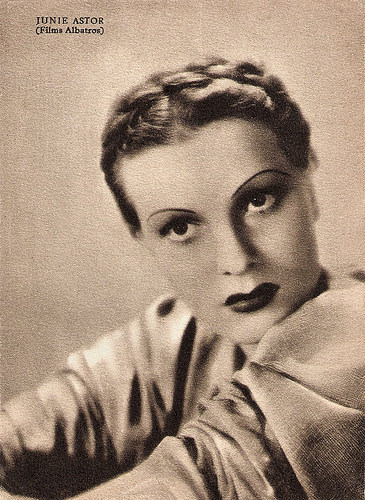
Italian postcard by Rizzoli E C., Milano, 1941. Photo: Films Albatros. Publicity still for Les Bas-fonds/The Lower Depths (Jean Renoir, 1936).
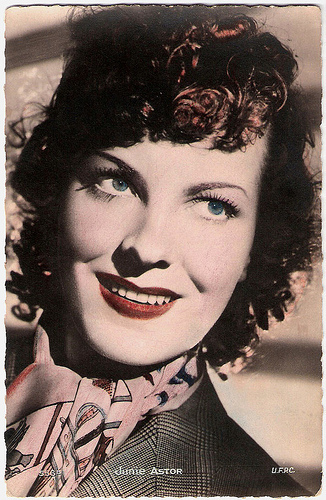
French postcard by Ed. Chantal, Rueil, no. 556B. Photo: U.F.P.C
Non-photogenic
Junie Astor was born as Rolande Jeanne Risterucci in Marseille, France in 1911. She was obliged to learn classic ballet which she abandoned for lessons at the Conservatoire National Supérieur d’Art Dramatique.
This formation permitted her to have her début on stage in the play Lundi 8 heures (Monday at Eight) at the Théâtre des Ambassadeurs in 1933, in the company of Julien Carette. The same year Junie Astor also started in the cinema with D’amour et d’eau fraîche/Love and Cool Water (Félix Gandéra, 1933), with Fernandel .
The beautiful newcomer made her mark in Ademaï aviateur/Skylark (Jean Tarride, 1934) with Noël-Noël . From then on, she played one (supporting) part after another, such as in Tovarich (Jacques Deval, 1934) with André Lefaur and Irène de Zilahy, Mayerling (Anatole Litvak, 1936) with Charles Boyer and Danielle Darrieux , and in Club de femmes (Jacques Deval, 1936).
On the instigation of her paramour, producer Alexander Kamenka, Astor played Jean Gabin 's love interest in Jean Renoir’s liberal adaptation of Maxim Gorki’s The Lower Depths: Les bas-fonds (1936), though the real leads were for Gabin as the bum and thief Pepel and Louis Jouvet as the impoverished Baron. Years later Renoir gave a severe critique, condemning Astor as non-photogenic.
Not everybody thought that way, though, because in 1937 Astor won the first Prix Suzanne Bianchetti for the most promising female acting talent of the year. Suzanne Bianchetti had been an actress in the French silent cinema, and her husband the critic René Jeanne had created the award. The award comes in the form of a medallion engraved with Suzanne Bianchetti's image. Since its inception, the Prix Suzanne Bianchetti has been annually awarded to many of the greatest names in French cinema who went on to national and international stardom.
Despite the prestigious award Astor had to be satisfied with mere supporting roles. However she had an active career in the 1930s, and worked with some of the most important directors of the era. Highlights were the Marcel Achard adaptation Noix de coco/Cocoanut (Jean Boyer, 1939) with Raimu and Marie Bell , and Battement de cœur/Beating Heart (Henri Decoin, 1940) with Danielle Darrieux and Claude Dauphin .
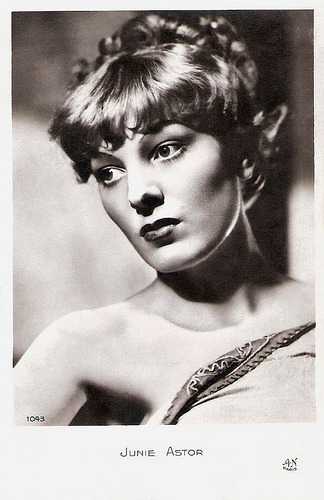
French postcard by A.N., Paris, no. 1043.
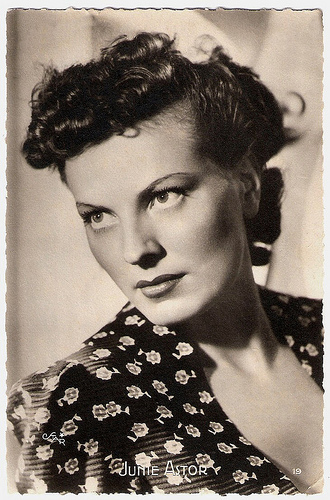
French postcard by Editions O.P., Paris, no. 19. Photo: Star.
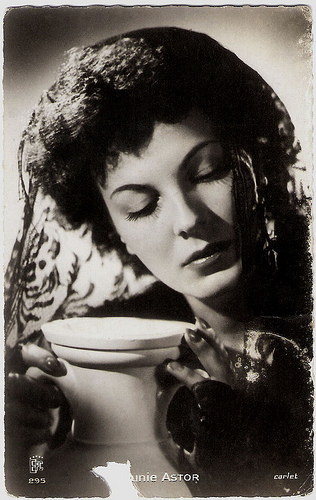
French postcard by Editions et Publications Cinematographiques (EPC), no. 295. Photo: Carlet.
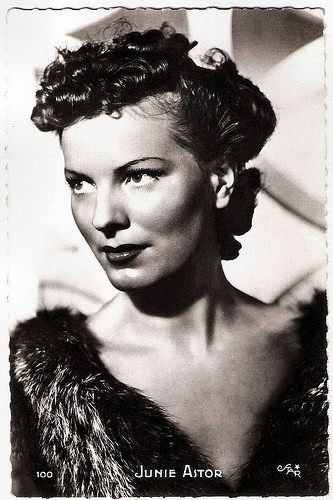
French postcard by Editions P.I., Paris, no. 100. Photo: Star, Paris.
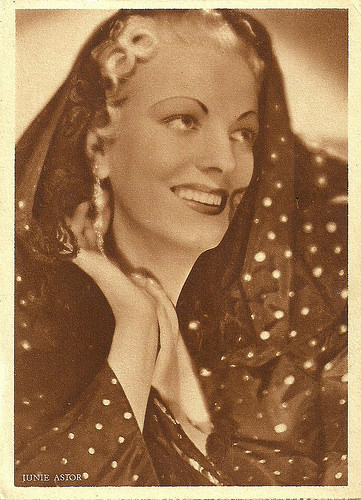
Italian postcard by Rizzoli, Milano, 1940. In 1940, Junie Astor acted in the Italian film Tutto per la donna/Everything For The Woman (Mario Soldati, 1940).
Train of Shame
In 1939-1940 Junie Astor tried her luck in Italy with such films as Tutto per la donna/Everything For The Woman (Mario Soldati, 1940) with Antonio Centa , but these productions were not shown in France. The year before she had acted in the Italian films Un mare di guai/A lot of trouble (Carlo Ludovico Bragaglia, 1939) and Il carnevale di Venezia/The Carnival of Venice (Giuseppe Adami, Giacomo Gentilomo, 1939).
In 1942 she was back in France to appear in L’éternel retour/Love Eternal (Jean Delannoy, 1943) with Madeleine Sologne and Jean Marais . Together with Danielle Darrieux , Suzy Delair , René Dary , Albert Préjean and Viviane Romance , Junie Astor was part of the so-called ‘train of shame’ that went to Nazi-Berlin in March 1942 to visit the Berlin film studios. The reason for the visit was the première of Premier rendez-vous/Her First Affair (Henri Decoin, 1942) starring Darrieux. If Danielle Darrieux’ presence was explainable, for she wanted to liberate her husband Porfirio Rubirosa, one wonders why the other actors, working for the Franco-German Continental company, accepted to join this masquerade set up to legitimise the Nazi regime.
After the Liberation Astor had one last major role in Du Guesclin (Bernard de La Tour, 1948), a chronicle of the life of Bertrand du Guesclin, grand officer of the French army in the 14th century featuring Fernand Gravey . Astor married her director Bernard De la Tour and they founded Astor Production, but the promising initiative didn’t struck ground – the marriage neither (they split after six years).
Astor nevertheless joined Raymond Pellegrin in Coupable?/Culprit? (Yvan Noé, 1950) and Eddie Constantine , Noël-Noël and Jean Richard in the comedy Les truands/Lock Up Your Spoons (Carlo Rim, 1956). Astor also returned to the stage in Ombre chère (Dear Shadow, 1952) by Jacques Deval and with Robert Lamoureux .
In the 1960s she played in such crime films as Interpol contre X/Interpol Contra X (Maurice Boutel, 1960) and L’homme de l’Interpol/The Man From Interpol (Maurice Boutel, 1966), but these B-series policiers didn’t help her career. Tired of her profession Astor focused on the exploitation of two Parisian cinemas, Astor and Rio Opéra.
She finished her film career with Joë Caligula - Du suif chez les dabes/Joe Caligula: Tallow for the Old Men (José Bénazéraf, 1966) with Gérard Blain , a film that for two years would remain forbidden by the French censors. Christopher Underwood at IMDb : "Splendid, sparkling black and white widescreen crime caper from Jose Benazeraf. Occasionally resembling a US 'roughie' this is a stylised Movie with, very much, the look of the french new wave. Surprisingly violent with some battle between a bunch of cool kids and the more established crooks and pimps."
Junie Astor died at the age of 55 years, because of a car accident in 1967 in Sainte-Magnance, France. She lies buried at the cemetery of Bagneux.
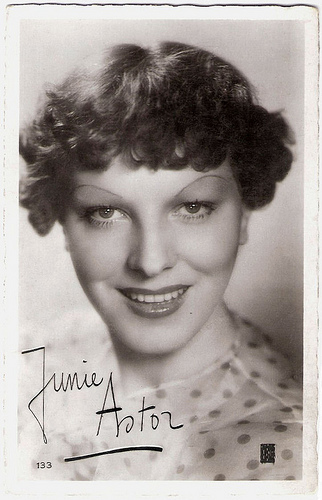
French postcard by Editions et Publications Cinematographiques (EPC), no. 133.
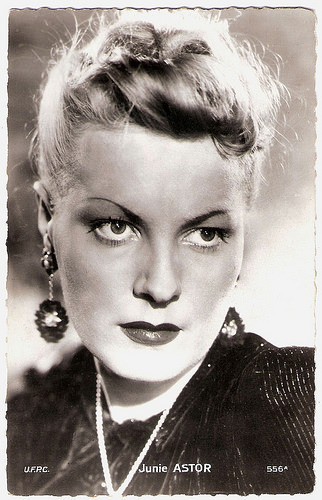
French postcard by Edit. Chantal, Rueil, no. 556A. Photo: U.F.P.C.
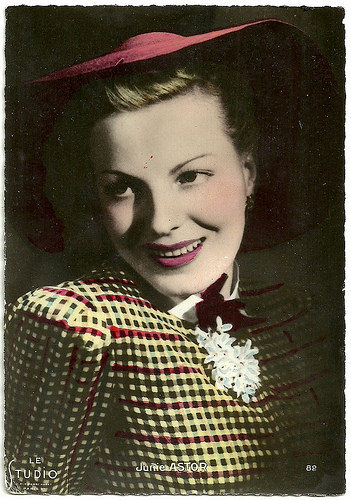
French postcard by Editions O.P., Paris, no. 82. Photo: Le Studio, Paris.
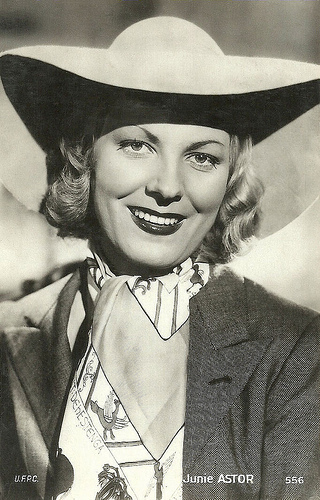
French postcard, no. 556. Photo: U.F.P.C
Sources: Olivier Sinqsous (Ciné-Artistes - French), Christopher Underwood (IMDb), Wikipedia (English and French), and .

French postcard by Editions O.P., Paris, no. 35. Photo: Star, Paris.

French postcard by Massilia. Photo: Filma Albatros. Publicity still for Les Bas-fonds/The Lower Depths (Jean Renoir, 1936).

Italian postcard by Rizzoli E C., Milano, 1941. Photo: Films Albatros. Publicity still for Les Bas-fonds/The Lower Depths (Jean Renoir, 1936).

French postcard by Ed. Chantal, Rueil, no. 556B. Photo: U.F.P.C
Non-photogenic
Junie Astor was born as Rolande Jeanne Risterucci in Marseille, France in 1911. She was obliged to learn classic ballet which she abandoned for lessons at the Conservatoire National Supérieur d’Art Dramatique.
This formation permitted her to have her début on stage in the play Lundi 8 heures (Monday at Eight) at the Théâtre des Ambassadeurs in 1933, in the company of Julien Carette. The same year Junie Astor also started in the cinema with D’amour et d’eau fraîche/Love and Cool Water (Félix Gandéra, 1933), with Fernandel .
The beautiful newcomer made her mark in Ademaï aviateur/Skylark (Jean Tarride, 1934) with Noël-Noël . From then on, she played one (supporting) part after another, such as in Tovarich (Jacques Deval, 1934) with André Lefaur and Irène de Zilahy, Mayerling (Anatole Litvak, 1936) with Charles Boyer and Danielle Darrieux , and in Club de femmes (Jacques Deval, 1936).
On the instigation of her paramour, producer Alexander Kamenka, Astor played Jean Gabin 's love interest in Jean Renoir’s liberal adaptation of Maxim Gorki’s The Lower Depths: Les bas-fonds (1936), though the real leads were for Gabin as the bum and thief Pepel and Louis Jouvet as the impoverished Baron. Years later Renoir gave a severe critique, condemning Astor as non-photogenic.
Not everybody thought that way, though, because in 1937 Astor won the first Prix Suzanne Bianchetti for the most promising female acting talent of the year. Suzanne Bianchetti had been an actress in the French silent cinema, and her husband the critic René Jeanne had created the award. The award comes in the form of a medallion engraved with Suzanne Bianchetti's image. Since its inception, the Prix Suzanne Bianchetti has been annually awarded to many of the greatest names in French cinema who went on to national and international stardom.
Despite the prestigious award Astor had to be satisfied with mere supporting roles. However she had an active career in the 1930s, and worked with some of the most important directors of the era. Highlights were the Marcel Achard adaptation Noix de coco/Cocoanut (Jean Boyer, 1939) with Raimu and Marie Bell , and Battement de cœur/Beating Heart (Henri Decoin, 1940) with Danielle Darrieux and Claude Dauphin .

French postcard by A.N., Paris, no. 1043.

French postcard by Editions O.P., Paris, no. 19. Photo: Star.

French postcard by Editions et Publications Cinematographiques (EPC), no. 295. Photo: Carlet.

French postcard by Editions P.I., Paris, no. 100. Photo: Star, Paris.

Italian postcard by Rizzoli, Milano, 1940. In 1940, Junie Astor acted in the Italian film Tutto per la donna/Everything For The Woman (Mario Soldati, 1940).
Train of Shame
In 1939-1940 Junie Astor tried her luck in Italy with such films as Tutto per la donna/Everything For The Woman (Mario Soldati, 1940) with Antonio Centa , but these productions were not shown in France. The year before she had acted in the Italian films Un mare di guai/A lot of trouble (Carlo Ludovico Bragaglia, 1939) and Il carnevale di Venezia/The Carnival of Venice (Giuseppe Adami, Giacomo Gentilomo, 1939).
In 1942 she was back in France to appear in L’éternel retour/Love Eternal (Jean Delannoy, 1943) with Madeleine Sologne and Jean Marais . Together with Danielle Darrieux , Suzy Delair , René Dary , Albert Préjean and Viviane Romance , Junie Astor was part of the so-called ‘train of shame’ that went to Nazi-Berlin in March 1942 to visit the Berlin film studios. The reason for the visit was the première of Premier rendez-vous/Her First Affair (Henri Decoin, 1942) starring Darrieux. If Danielle Darrieux’ presence was explainable, for she wanted to liberate her husband Porfirio Rubirosa, one wonders why the other actors, working for the Franco-German Continental company, accepted to join this masquerade set up to legitimise the Nazi regime.
After the Liberation Astor had one last major role in Du Guesclin (Bernard de La Tour, 1948), a chronicle of the life of Bertrand du Guesclin, grand officer of the French army in the 14th century featuring Fernand Gravey . Astor married her director Bernard De la Tour and they founded Astor Production, but the promising initiative didn’t struck ground – the marriage neither (they split after six years).
Astor nevertheless joined Raymond Pellegrin in Coupable?/Culprit? (Yvan Noé, 1950) and Eddie Constantine , Noël-Noël and Jean Richard in the comedy Les truands/Lock Up Your Spoons (Carlo Rim, 1956). Astor also returned to the stage in Ombre chère (Dear Shadow, 1952) by Jacques Deval and with Robert Lamoureux .
In the 1960s she played in such crime films as Interpol contre X/Interpol Contra X (Maurice Boutel, 1960) and L’homme de l’Interpol/The Man From Interpol (Maurice Boutel, 1966), but these B-series policiers didn’t help her career. Tired of her profession Astor focused on the exploitation of two Parisian cinemas, Astor and Rio Opéra.
She finished her film career with Joë Caligula - Du suif chez les dabes/Joe Caligula: Tallow for the Old Men (José Bénazéraf, 1966) with Gérard Blain , a film that for two years would remain forbidden by the French censors. Christopher Underwood at IMDb : "Splendid, sparkling black and white widescreen crime caper from Jose Benazeraf. Occasionally resembling a US 'roughie' this is a stylised Movie with, very much, the look of the french new wave. Surprisingly violent with some battle between a bunch of cool kids and the more established crooks and pimps."
Junie Astor died at the age of 55 years, because of a car accident in 1967 in Sainte-Magnance, France. She lies buried at the cemetery of Bagneux.

French postcard by Editions et Publications Cinematographiques (EPC), no. 133.

French postcard by Edit. Chantal, Rueil, no. 556A. Photo: U.F.P.C.

French postcard by Editions O.P., Paris, no. 82. Photo: Le Studio, Paris.

French postcard, no. 556. Photo: U.F.P.C
Sources: Olivier Sinqsous (Ciné-Artistes - French), Christopher Underwood (IMDb), Wikipedia (English and French), and .
Published on January 26, 2017 22:00
January 25, 2017
Terence Morgan
Tall, dark and charming English actor Terence Morgan (1921-2005) played many attractive villains and criminals in British films. But he is probably best remembered for his starring role in the TV historical adventure series Sir Francis Drake (1961-1962), about the first Englishman to sail round the world. After this success, parts started to dry up as Morgan was no longer seen as ‘the bad guy’.
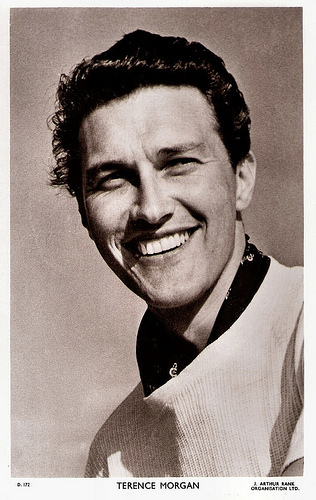
British postcard in the Picturegoer series, London, no. D 172. Photo: J. Arthur Rank Organisation LTD.
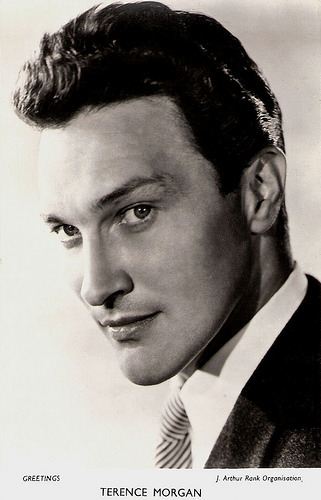
British Greetings card. Photo: J. Arthur Rank Organisation.
Daring, dashing and tempestuous
Terence Ivor Grant Morgan was born in Lewisham, London, in 1921. He was the nephew of British character actor Verne Morgan. He started work as a shipping clerk at Lloyd's of London before winning a scholarship to the Royal Academy of Dramatic Art (RADA).
After training at RADA, Morgan began as a repertory theatre actor. His career was interrupted by two years in the army in World War II before he was invalided out with claustrophobia and returned to the stage. He played in Robert E. Sherwood's Pulitzer Prize-winning play There Shall Be No Night in London's West End.
Laurence Olivier spotted the handsome Morgan and gave him the role of Cain in Thornton Wilder's classic Skin of Our Teeth. This 1945 production which also starred Vivien Leigh , proved a huge boost to his career. Morgan joined the Old Vic Company alongside Olivier, playing parts in Richard Brinsley Sheridan and William Shakespeare.
He made his film debut in the role of Laertes opposite Olivier’s Hamlet in the film adaptation of William Shakespeare's Hamlet (Laurence Olivier, 1948). Ronald Bergan in The Guardian : “His Laertes (…) was everything a Laertes should be: daring, dashing and tempestuous. And, at 27, he was young enough to make a convincing student, 14 years younger than Olivier's over-age Hamlet. He wields his sword with aplomb before dying beautifully in Peter Cushing's arms.”
Morgan was probably the first actor in the part to get fan mail from teenage girls. Hamlet is still the Shakespeare film that has received the most prestigious accolades, winning the Academy Awards for Best Picture and Best Actor and the Golden Lion at the Venice Film Festival.
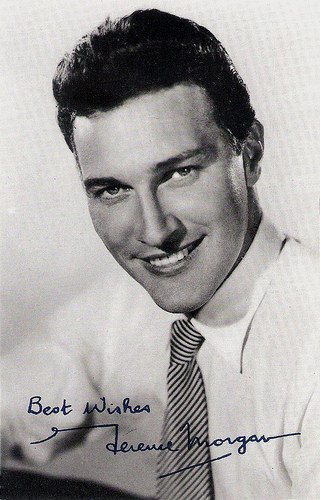
British postcard by L.D. LTD., London, in the Film Star Autograph Portrait series, no. 55. Photo: J. Arthur Rank Organisation LTD.
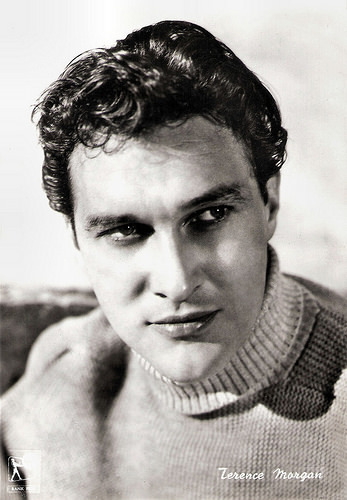
Italian postcard by Bromofoto, Milano, no. 1004. Photo: Rank Film. Publicity still for Dance Little Lady (Val Guest, 1954).
Nasty roles and dramatic exits
Terence Morgan signed a contract with the Rank studio. He played a support to Gregory Peck and Virginia Mayo in the American adventure film Captain Horatio Hornblower RN (Raoul Walsh, 1951), made in England. In Mandy (Alexander Mackendrick, 1952) he played the insensitive father of a deaf girl.
In Gigolo And Gigolette, one of the three W. Somerset Maugham stories in Encore (Harold French, 1951) he played a cad risking the life of his wife (Glynis Johns). In 1953 he again played a villain in Turn the Key Softly (Jack Lee, 1953) as a crook who gets his well-bred girlfriend (Yvonne Mitchell) a prison sentence for helping him in a burglary.
More nasty roles quickly followed with Always a Bride (Ralph Smart, 1953) where he played a Treasury Investigator who turns bad, as well as Forbidden Cargo (Harold French, 1954) as a smuggler, and Tread Softly Stranger (Gordon Parry, 1958) where he is an embezzler and murderer, who robs a steel mill in order to keep his girlfriend Diana Dors in fancy clothes.
He was often given dramatic exits: Dance Little Lady (Val Guest, 1954) saw him fry in the conflagration at the end, The Scamp (Wolf Rilla, 1957) had him suffer a fatal fall down a flight of stairs, and in Forbidden Cargo (Harold French, 1954), he attempted to drive across Tower Bridge as it was opening and drowned in the Thames.
Two films he made in 1955 saw him cast in more positive roles - in the espionage melodrama They Can't Hang Me (Val Guest, 1955) he starred as a dapper Special Branch officer charged with discovering the identity of an enemy agent, and in The March Hare (George More O'Ferrall, 1956) he played an impoverished aristocrat riding a horse for the Derby.
One of his nastiest roles was in crime drama The Shakedown (John Lemont, 1959), when he played a pornographer and blackmailer. He just played a petty thief planning a big haul in the thriller Piccadilly Third Stop (Wolf Rilla, 1960) with Yoko Tani .
In 1958, Morgan bought a small hotel in Hove, Sussex, and ran the hotel for 16 years.
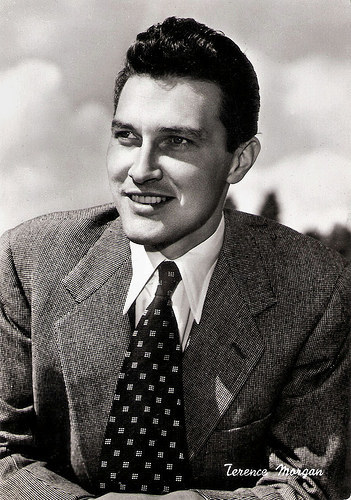
Italian postcard by Bromofoto, Milano, no. 473.
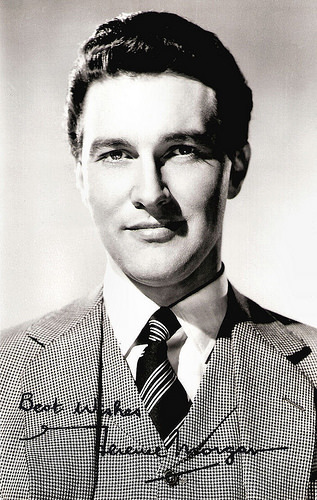
British autograph card. Photo: J. Arthur Rank Organisation.
The villainous brother of the mummy
When his Rank contract finished, Terence Morgan had his biggest screen success. He landed the title role in the British adventure television series TV series Sir Francis Drake (Clive Donner, Harry Booth, 1961-1962).
Drake is the commander of the sailing ship the Golden Hind during the 1500s and one of the most famous explorers of the high seas. As well as battles at sea and sword fights, the series also deals with intrigue at the court of Queen Elizabeth (Jean Kent).
During his career, Morgan appeared in 20 films and later notable roles included the villainous brother of the mummy (Rameses VIII) in the Hammer horror film Curse of the Mummy's Tomb (Michael Carreras, 1964), Lord Blackwood in the successful French-Spanish-Italian adventure film Surcouf, le tigre des sept mers/The Sea Pirate (Sergio Bergonzelli, Roy Rowland, 1966) starring Gérard Barray , and an estate agent who is forced to watch as his girlfriend (Suzy Kendall) is abused by thugs in the shocker The Penthouse (Peter Collinson, 1967).
Since roles dried up, he spent an increasing amount of time as a property developer in Brighton and Hove. Incidentally he appeared in films like Hide and Seek (David Eady, 1972) with a young Gary Kemp, and The Lifetaker (Michael Papas, 1976), which had him back as the bad guy again where as a wealthy business man he plans ritualistic revenge on his wife and her lover.
Later he gave a haunting performance on television as an ageing, homosexual matinee idol being blackmailed in an episode of King and Castle (1986) and he had a small part in The Mystery of Edwin Drood (Timothy Forder, 1993), based on the novel by Charles Dickens.
In 2005, Terence Morgan died of a heart attack in Brighton, England. He was 83. Since 1945, he was married to actress Georgina Jumel. The couple had a daughter.
Long scene from Tread Softly Stranger (1958) with Diana Dors . Source: Paul Thompson (YouTube).
Trailer of The Penthouse (1967). Source: DEATHTRAP TRAILERS (YouTube).
Sources: Ronald Bergan (The Guardian), Anthony Hayward (The Independent), The Telegraph, Wikipedia and .

British postcard in the Picturegoer series, London, no. D 172. Photo: J. Arthur Rank Organisation LTD.

British Greetings card. Photo: J. Arthur Rank Organisation.
Daring, dashing and tempestuous
Terence Ivor Grant Morgan was born in Lewisham, London, in 1921. He was the nephew of British character actor Verne Morgan. He started work as a shipping clerk at Lloyd's of London before winning a scholarship to the Royal Academy of Dramatic Art (RADA).
After training at RADA, Morgan began as a repertory theatre actor. His career was interrupted by two years in the army in World War II before he was invalided out with claustrophobia and returned to the stage. He played in Robert E. Sherwood's Pulitzer Prize-winning play There Shall Be No Night in London's West End.
Laurence Olivier spotted the handsome Morgan and gave him the role of Cain in Thornton Wilder's classic Skin of Our Teeth. This 1945 production which also starred Vivien Leigh , proved a huge boost to his career. Morgan joined the Old Vic Company alongside Olivier, playing parts in Richard Brinsley Sheridan and William Shakespeare.
He made his film debut in the role of Laertes opposite Olivier’s Hamlet in the film adaptation of William Shakespeare's Hamlet (Laurence Olivier, 1948). Ronald Bergan in The Guardian : “His Laertes (…) was everything a Laertes should be: daring, dashing and tempestuous. And, at 27, he was young enough to make a convincing student, 14 years younger than Olivier's over-age Hamlet. He wields his sword with aplomb before dying beautifully in Peter Cushing's arms.”
Morgan was probably the first actor in the part to get fan mail from teenage girls. Hamlet is still the Shakespeare film that has received the most prestigious accolades, winning the Academy Awards for Best Picture and Best Actor and the Golden Lion at the Venice Film Festival.

British postcard by L.D. LTD., London, in the Film Star Autograph Portrait series, no. 55. Photo: J. Arthur Rank Organisation LTD.

Italian postcard by Bromofoto, Milano, no. 1004. Photo: Rank Film. Publicity still for Dance Little Lady (Val Guest, 1954).
Nasty roles and dramatic exits
Terence Morgan signed a contract with the Rank studio. He played a support to Gregory Peck and Virginia Mayo in the American adventure film Captain Horatio Hornblower RN (Raoul Walsh, 1951), made in England. In Mandy (Alexander Mackendrick, 1952) he played the insensitive father of a deaf girl.
In Gigolo And Gigolette, one of the three W. Somerset Maugham stories in Encore (Harold French, 1951) he played a cad risking the life of his wife (Glynis Johns). In 1953 he again played a villain in Turn the Key Softly (Jack Lee, 1953) as a crook who gets his well-bred girlfriend (Yvonne Mitchell) a prison sentence for helping him in a burglary.
More nasty roles quickly followed with Always a Bride (Ralph Smart, 1953) where he played a Treasury Investigator who turns bad, as well as Forbidden Cargo (Harold French, 1954) as a smuggler, and Tread Softly Stranger (Gordon Parry, 1958) where he is an embezzler and murderer, who robs a steel mill in order to keep his girlfriend Diana Dors in fancy clothes.
He was often given dramatic exits: Dance Little Lady (Val Guest, 1954) saw him fry in the conflagration at the end, The Scamp (Wolf Rilla, 1957) had him suffer a fatal fall down a flight of stairs, and in Forbidden Cargo (Harold French, 1954), he attempted to drive across Tower Bridge as it was opening and drowned in the Thames.
Two films he made in 1955 saw him cast in more positive roles - in the espionage melodrama They Can't Hang Me (Val Guest, 1955) he starred as a dapper Special Branch officer charged with discovering the identity of an enemy agent, and in The March Hare (George More O'Ferrall, 1956) he played an impoverished aristocrat riding a horse for the Derby.
One of his nastiest roles was in crime drama The Shakedown (John Lemont, 1959), when he played a pornographer and blackmailer. He just played a petty thief planning a big haul in the thriller Piccadilly Third Stop (Wolf Rilla, 1960) with Yoko Tani .
In 1958, Morgan bought a small hotel in Hove, Sussex, and ran the hotel for 16 years.

Italian postcard by Bromofoto, Milano, no. 473.

British autograph card. Photo: J. Arthur Rank Organisation.
The villainous brother of the mummy
When his Rank contract finished, Terence Morgan had his biggest screen success. He landed the title role in the British adventure television series TV series Sir Francis Drake (Clive Donner, Harry Booth, 1961-1962).
Drake is the commander of the sailing ship the Golden Hind during the 1500s and one of the most famous explorers of the high seas. As well as battles at sea and sword fights, the series also deals with intrigue at the court of Queen Elizabeth (Jean Kent).
During his career, Morgan appeared in 20 films and later notable roles included the villainous brother of the mummy (Rameses VIII) in the Hammer horror film Curse of the Mummy's Tomb (Michael Carreras, 1964), Lord Blackwood in the successful French-Spanish-Italian adventure film Surcouf, le tigre des sept mers/The Sea Pirate (Sergio Bergonzelli, Roy Rowland, 1966) starring Gérard Barray , and an estate agent who is forced to watch as his girlfriend (Suzy Kendall) is abused by thugs in the shocker The Penthouse (Peter Collinson, 1967).
Since roles dried up, he spent an increasing amount of time as a property developer in Brighton and Hove. Incidentally he appeared in films like Hide and Seek (David Eady, 1972) with a young Gary Kemp, and The Lifetaker (Michael Papas, 1976), which had him back as the bad guy again where as a wealthy business man he plans ritualistic revenge on his wife and her lover.
Later he gave a haunting performance on television as an ageing, homosexual matinee idol being blackmailed in an episode of King and Castle (1986) and he had a small part in The Mystery of Edwin Drood (Timothy Forder, 1993), based on the novel by Charles Dickens.
In 2005, Terence Morgan died of a heart attack in Brighton, England. He was 83. Since 1945, he was married to actress Georgina Jumel. The couple had a daughter.
Long scene from Tread Softly Stranger (1958) with Diana Dors . Source: Paul Thompson (YouTube).
Trailer of The Penthouse (1967). Source: DEATHTRAP TRAILERS (YouTube).
Sources: Ronald Bergan (The Guardian), Anthony Hayward (The Independent), The Telegraph, Wikipedia and .
Published on January 25, 2017 22:00
January 24, 2017
Herr Arnes pengar (1919)
The Swedish silent masterpiece Herr Arnes pengar/Sir Arne's Treasure (Mauritz Stiller, 1919) is a crime-drama based on Selma Lagerlöf’s novel The Treasure. Set on the Swedish coast in the 16th century, the film stars Richard Lund as Sir Archie, a Scottish mercenary who has escaped from a Scottish prison and fled to Sweden.
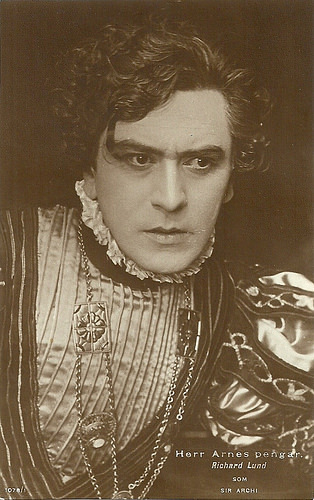
Swedish postcard by Nordisk Konst, Stockholm, no. 1078/1. Photo: Richard Lund in Herr Arnes pengar/Sir Arne's Treasure (Mauritz Stiller 1919).
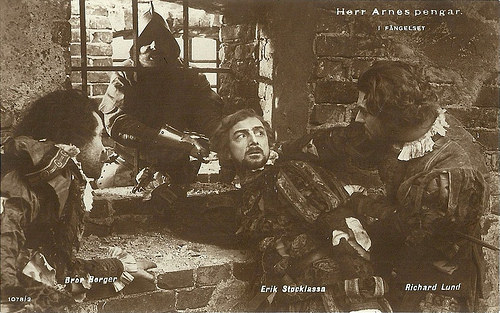
Swedish postcard by Nordisk Konst, Stockholm, no. 1078/2. Photo: Richard Lund, Bror Berger and Erik Stocklassa in Herr Arnes pengar/Sir Arne's Treasure (Mauritz Stiller, 1919). Caption: In Prison.
Forces of nature can't be conquered
Swedish film and theatre actor Richard Lund (1885–1960) was a prolific star of the early Scandinavian cinema. He worked for the two most important Swedish directors of the silent era, Victor Sjöström and Mauritz Stiller. The crime drama Herr Arnes pengar (1919) was directed by the latter.
Lund plays a Scottish mercenary who, together with his cronies Sir Donald (Bror Berger) and Sir Filip (Erik Stocklassa), has escaped from a Scottish prison and fled to Sweden.
There he murders the family of Sir Arne to obtain a treasure, after which he unknowingly starts an affair with the daughter of the murdered family, Elsalill (Mary Johnson).
Sir Arne’s Treasure still goes as one of if not the masterpiece of the Swedish silent cinema. Jerzy Toeplitz wrote in his Geschichte des Films (1972): “As with Sjöström, Nature plays a leading role in Stiller. Already in the first images the snow creates the atmosphere of the action. In the tragic finale, the sea becomes a contributor. In the small port of Marstrand lies the ship that should return the Scots to their home. But it is wedged by ice floes. [...]
When the situation is strained to the utmost, because the forces of nature can't be conquered, in the city the news spreads that the criminals want to flee. In the battle with the town guards, Elsalill dies and Sir John Archie is captured. A long train of grey-clad women arrives at the ship to take off the corpse of Elsalill, after which the ice bursts, and the occupied ship begins to move. Too late the silent, dangerous sea shows up.”
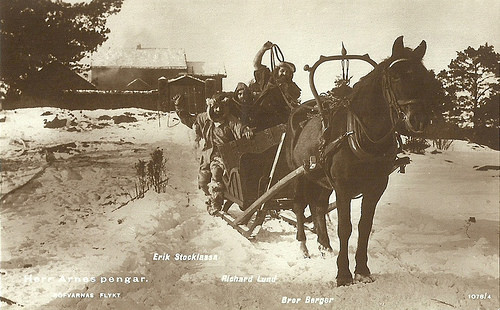
Swedish postcard by Nordisk Konst, Stockholm, no. 1078/4. Photo: Richard Lund, Bror Berger and Erik Stocklassa in Herr Arnes pengar/Sir Arne's Treasure (Mauritz Stiller, 1919). Caption: The Robbers' Escape.
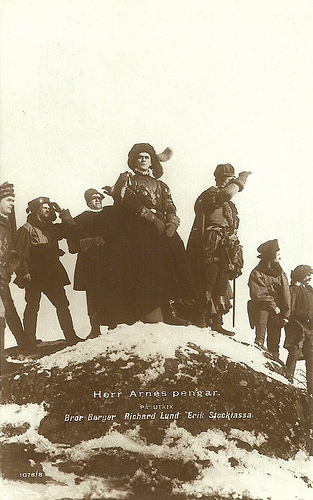
Swedish postcard by Nordisk Konst, Stockholm, no. 1078/8. Photo: Richard Lund, Bror Berger and Erik Stocklassa in Herr Arnes pengar/Sir Arne's Treasure (Mauritz Stiller, 1919). Caption: On the Lookout.
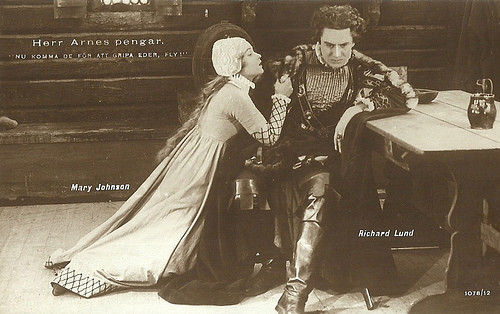
Swedish postcard by Nordisk Konst, Stockholm, no. 1078/12. Photo: Richard Lund and Mary Johnson in Herr Arnes pengar/Sir Arne's Treasure (Mauritz Stiller, 1919). Caption: They have come now to arrest you, escape!
Sources: Jerzy Toeplitz (Geschichte des Films - German), Wikipedia and IMDb.

Swedish postcard by Nordisk Konst, Stockholm, no. 1078/1. Photo: Richard Lund in Herr Arnes pengar/Sir Arne's Treasure (Mauritz Stiller 1919).

Swedish postcard by Nordisk Konst, Stockholm, no. 1078/2. Photo: Richard Lund, Bror Berger and Erik Stocklassa in Herr Arnes pengar/Sir Arne's Treasure (Mauritz Stiller, 1919). Caption: In Prison.
Forces of nature can't be conquered
Swedish film and theatre actor Richard Lund (1885–1960) was a prolific star of the early Scandinavian cinema. He worked for the two most important Swedish directors of the silent era, Victor Sjöström and Mauritz Stiller. The crime drama Herr Arnes pengar (1919) was directed by the latter.
Lund plays a Scottish mercenary who, together with his cronies Sir Donald (Bror Berger) and Sir Filip (Erik Stocklassa), has escaped from a Scottish prison and fled to Sweden.
There he murders the family of Sir Arne to obtain a treasure, after which he unknowingly starts an affair with the daughter of the murdered family, Elsalill (Mary Johnson).
Sir Arne’s Treasure still goes as one of if not the masterpiece of the Swedish silent cinema. Jerzy Toeplitz wrote in his Geschichte des Films (1972): “As with Sjöström, Nature plays a leading role in Stiller. Already in the first images the snow creates the atmosphere of the action. In the tragic finale, the sea becomes a contributor. In the small port of Marstrand lies the ship that should return the Scots to their home. But it is wedged by ice floes. [...]
When the situation is strained to the utmost, because the forces of nature can't be conquered, in the city the news spreads that the criminals want to flee. In the battle with the town guards, Elsalill dies and Sir John Archie is captured. A long train of grey-clad women arrives at the ship to take off the corpse of Elsalill, after which the ice bursts, and the occupied ship begins to move. Too late the silent, dangerous sea shows up.”

Swedish postcard by Nordisk Konst, Stockholm, no. 1078/4. Photo: Richard Lund, Bror Berger and Erik Stocklassa in Herr Arnes pengar/Sir Arne's Treasure (Mauritz Stiller, 1919). Caption: The Robbers' Escape.

Swedish postcard by Nordisk Konst, Stockholm, no. 1078/8. Photo: Richard Lund, Bror Berger and Erik Stocklassa in Herr Arnes pengar/Sir Arne's Treasure (Mauritz Stiller, 1919). Caption: On the Lookout.

Swedish postcard by Nordisk Konst, Stockholm, no. 1078/12. Photo: Richard Lund and Mary Johnson in Herr Arnes pengar/Sir Arne's Treasure (Mauritz Stiller, 1919). Caption: They have come now to arrest you, escape!
Sources: Jerzy Toeplitz (Geschichte des Films - German), Wikipedia and IMDb.
Published on January 24, 2017 22:00
Paul van Yperen's Blog
- Paul van Yperen's profile
- 13 followers
Paul van Yperen isn't a Goodreads Author
(yet),
but they
do have a blog,
so here are some recent posts imported from
their feed.



